Daily Current Affairs (January 07, 2022)
Paste the article.
Paste the article.
THE CONTEXT: Researchers found that global air temperature decreases by 0.03~0.08 °C, with strong regional contrasts and inter-annual variability, after 50 years of large-scale bioenergy crop cultivation.
THE EXPLANATION:
Importance:
What are Bioenergy Crops?
Impacts on Environment:
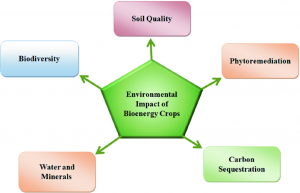
THE CONTEXT: The Union Ministry of Food Processing Industries launched six, One District One Product (ODOP) brands under the Pradhan Mantri Formalizations of Micro food processing Enterprises (PMFME) Scheme.
THE EXPLANATION:
Value Addition:
PMFME Scheme
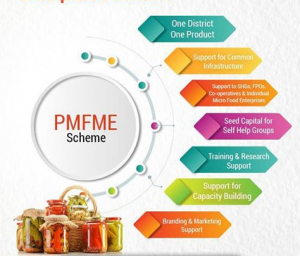
A major component of the scheme
One District One Product
About NAFED:
THE CONTEXT: The notification from the Union Ministry of Environment, Forest and Climate Change intends to “bring out a comprehensive framework for ash utilization including a system of environmental compensation based on the polluter-pays principle”.
THE EXPLANATION:
The New Rule highlights:
BACKGROUND:
What do experts say?
Value Addition:
What is Fly Ash?
Composition:
Applications:
Health and environmental hazards:
THE CONTEXT: A new early warning and hazard monitoring system, ThaiAWARE, will provide advanced decision support capabilities to Thailand’s disaster managers, protecting the country’s 70 million residents from natural disasters.
THE EXPLANATION:
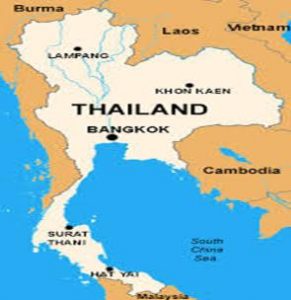
Q1. Bisphenol A (BPA), a cause of concern, is a structural/key component in the manufacture of which of the following kinds of plastics?
a) Low-density polyethylene
b) Polycarbonate
c) Polyethylene terephthalate
d) Polyvinyl chloride
ANSWER FOR 04TH JANUARY 2022
ANSWER: A
Explanation:
Dholavira: a Harappan city, is one of the very few well preserved urban settlements in South Asia dating from the 3rd to mid-2nd millennium BCE. Being the 6th largest of more than 1,000 Harappan sites discovered so far, and occupied for over 1,500 years, Dholavira not only witnesses the entire trajectory of the rise and fall of this early civilization of humankind, but also demonstrates its multifaceted achievements in terms of urban planning, construction techniques, water management, social governance and development, art, manufacturing, trading, and belief system. With extremely rich artifacts, the well-preserved urban settlement of Dholavira depicts a vivid picture of a regional center with its distinct characteristics, that also contribute significantly to the existing knowledge of Harappan Civilization as a whole.
The property comprises two parts: a walled city and a cemetery to the west of the city. The walled city consists of a fortified Castle with attached fortified Bailey and Ceremonial Ground, and a fortified Middle Town and Lower Town. A series of reservoirs are found to the east and south of the Citadel. The great majority of the burials in the Cemetery are memorial in nature.
THE CONTEXT: The Mines Ministry has created a joint venture (JV) company — Khanij Bidesh India (KABIL) — with participating interest from National Aluminium Company (NALCO), Hindustan Copper (HCL) and Mineral Exploration Corporation (MECL).
THE EXPLANATION:

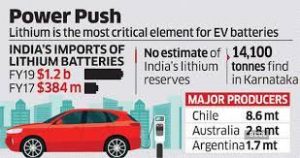
Importance of Cobalt and Lithium:
THE CONTEXT: NPCI Bharat BillPay (NBBL), the wholly-owned subsidiary of National Payments Corporation of India (NPCI), has introduced the ‘Unified Presentment Management System’ (UPMS) to simplify bill payments in the country.
THE EXPLANATION:
UNIFIED PRESENTMENT MANAGEMENT SYSTEM (UPMS)
DEPLOYMENT OF UPMS
SIGNIFICANCE OF UPMS
ABOUT NPCI
PRODUCTS OF NPCI
THE CONTEXT: Chilika Lake, the largest brackish water lake and wintering ground of the birds in the Indian subcontinent saw a million birds, including uncommon Mongolian gull, visiting the waterbody.
THE EXPLANATION:
VALUE ADDITION:
SIGNIFICANCE OF CHILIKA LAKE:
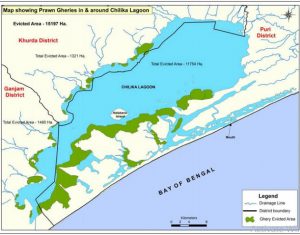
ABOUT BNHS:
THE CONTEXT: Rainfall trend analysis of Africa published in the journal Remote Sensing showed a significant increase in annual rainfall at the national level from 1983 to 2020 in almost all regions of the continent, except those in the south and the east.
THE EXPLANATION:
BACKGROUND:
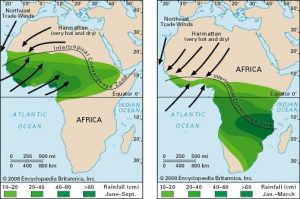
THE CONTEXT: The Centre wants the States to share more intelligence inputs through the Multi-Agency Centre (MAC), a common counter-terrorism grid under the Intelligence Bureau (IB) that was made operational in 2001 post-Kargil war.
THE EXPLANATION:
WHAT IS THE NEED?
According to the Home Ministry, “It is highlighting the continued threats of terrorism and global terror groups, terror financing, narco-terrorism, organized crime-terror nexus, illicit use of cyberspace, movement of foreign terrorist fighters, it also stressed upon the need for better coordination and synergy among the central and state security agencies in countering the ever-changing counter-terrorism and security challenges.
ABOUT THE CENTRE
Q1. Which one of the following ancient towns is well-known for its elaborate system of water harvesting and management by building a series of dams and channelizing water into connected reservoirs?
ANSWER FOR 04TH JANUARY 2022
ANSWER: C
THE CONTEXT: China is constructing a bridge in eastern Ladakh connecting the north and south banks of Pangong Tso (lake), which will significantly bring down the time for the People’s Liberation Army (PLA) to move troops and equipment between the two sectors.
THE EXPLANATION:

About Pangong Lake
THE CONTEXT: The Reserve Bank of India (RBI) has come out with the framework for facilitating small-value digital payments in offline mode, a move that would promote digital payments in semi-urban and rural areas.
THE EXPLANATION:
THE CONTEXT: Millions of Indians were pushed into poverty during the Covid-19 pandemic, but the period post the initial strict lockdown also saw a decline in income inequality in the country.
THE EXPLANATION:
THE CONTEXT: States are seeking an extension of GST compensation for five more years.
WHAT IS GST COMPENSATION?
HOW IS IT FUNDED?
WHO PAYS COMPENSATION TO WHOM? WHEN?
FOR HOW LONG WILL IT BE PAID?
WHY ARE STATES DEMANDING AN EXTENSION OF THE COMPENSATION?
THE CONTEXT: After a rather muted 2021 in terms of satellite launches, the Indian Space Research Organisation (ISRO) is gearing up for a number of missions in 2022 including the launch of the first unmanned mission of Gaganyaan, its Chairman, K. Sivan said.
THE CONTEXT: Gandhi Sagar Dam on Chambal River in Madhya Pradesh is in need of immediate repair, warned a new CAG report. It is one of the five water reservoirs of national importance.
THE EXPLANATION:
ABOUT GANDHI SAGAR DAM
Q1. With reference to Madanapalle of Andhra Pradesh, which one of the following statements is correct?
a) PingaliVenkayya designed the tricolor Indian National Flag here.
b) PattabhiSitaramaiah led the Quit India Movement of the Andhra region from here.
c) Rabindranath Tagore translated the National Anthem from Bengali to English here.
d) Madame Blavatsky and Colonel Olcott set up headquarters of Theosophical Society first here.
ANSWER FOR 31STDECEMBER 2021
Answer: D
Explanation:
Please refer to the following map of the Indus River System.
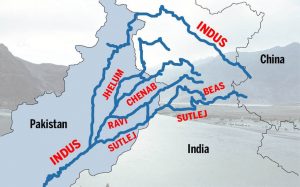
THE CONTEXT: The Odisha Forest and Environment Department has completed its first-ever radio-tagging of the Indian pangolin in an attempt to standardise the rehabilitation protocol for the animal in the State.
THE EXPLANATION:
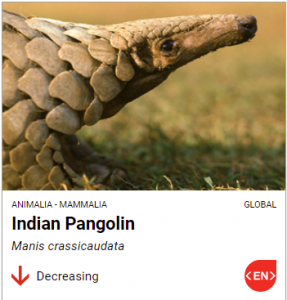
What is Radio Tagging?
Radio-tracking is the technique of determining information about an animal through the use of radio signals from or to a device carried by the animal. Most radio tracking systems involve transmitters tuned to different frequencies (analogous to different AM/FM radio stations) that allow individual identification.
About Indian Pangolin
The Indian pangolin or thick-tailed pangolin is a solitary, shy, slow moving, nocturnal mammal, Unlike other pangolin species, the Indian pangolin does not often climb trees. Pangolins or scaly anteaters (order Pholidota, meaning ‘scaled animals’) are a group of unusual mammals with tough, protective keratin scales.
Distribution: Bangladesh, India, Nepal, Pakistan and Sri Lanka.
Threats:
Conservation status:
THE CONTEXT: Ahead of assembly elections in five states, the Union government approved the issuance of the 19th tranche of electoral bonds which will be open for sale from January 1 to 10 2022.
THE EXPLANATION:
What are Electoral Bonds?

THE CONTEXT: The Government of India has extended the Armed Forces Special Powers Act, 1958 in Nagaland for another six months (June 30, 2022). The decision came days after the Home Ministry had instituted a high-level committee chaired by a Secretary-level officer for examining the possibility of AFSPA repeal in Nagaland.
THE EXPLANATION:
Govt demands repeal of the law
What is Armed Forces Special Powers Act (AFSPA)?

How is a region declared ‘disturbed’?

Criticism of AFSPA:
What should be done?
THE CONTEXT: China’s Ministry of Civil Affairs issued a statement stating that they have ‘standardised’ names for 15 places in Arunachal Pradesh, to be used on Chinese maps. This is the second time China has renamed the names of the places of Arunachal Pradesh.
THE EXPLANATION:
Why is China giving names to places that are in India?
“According to relevant regulations on the management of place names, the department has standardised some place names in China’s South Tibet region. We have released the first batch of the place names in South Tibet (six in total).
The latitude and longitude listed with the names showed those places as Tawang, KraDaadi, West Siang, Siang (where Mechuka or Menchuka is an emerging tourist destination), Anjaw, and Subansiri respectively.
These six places spanned the breadth of Arunachal Pradesh — “Wo’gyainling” in the west, “Bumo La” in the east and the other four located in the central part of the state.
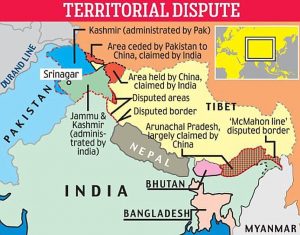
What is China’s argument for claiming these areas?
THE CONTEXT: The Sahitya Akademi announced its prestigious “Sahitya Akademi Awards, YuvaPuraskar as well as Bal Sahitya Puraskar” for 2021 in various languages.
THE EXPLANATION:
Other winners include:
Sahitya AkademiYuvaPuraskar 2021
Other winners of the award include:
Bal Sahitya Puraskar 2021
Other winners include:
The Sahitya Akademi Award
THE PRELIMS PRACTICE QUESTION
| Q1. With reference to the Indus river system, of the following four rivers, three of them
pour into one of them which joins the Indus direct. Among the following, which one is such river that joins the indus direct? (a) Chenab (b) Jhelum (c) Ravi (d) Sutlej ANSWER FOR 30THDECEMBER 2021 Answer: B |
THE CONTEXT: The Goa state Government permitting mining companies to export low-grade iron ore, paving the way for the resumption of mining activity that has been stalled since 2018.
THE EXPLANATION:
Value Addition:
The total recoverable reserves of iron ore in India are about 9,602 million tonnes of hematite and 3,408 million tonnes of magnetite. Chhattisgarh, Madhya Pradesh, Karnataka, Jharkhand, Odisha, Goa, Maharashtra, Andhra Pradesh, Kerala, Rajasthan and Tamil Nadu are the principal Indian producers of iron ore.
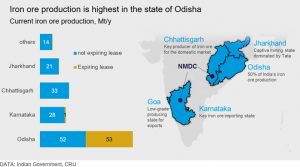
THE CONTEXT: Amid ongoing tensions between the Governor of Maharashtra and the State Government over the election to the Speaker of the Assembly, and the winter session of the state assembly ends but the Governor has not given his consent to the election programme recommended by the Cabinet.
THE EXPLANATION:
What Constitution says?
Article 178 of the Constitution states: “Every Legislative Assembly of a State shall, as soon as may be, choose two members of the Assembly to be respectively Speaker and Deputy Speaker thereof and, so often as the office of Speaker or Deputy Speaker becomes vacant, the Assembly shall choose another member to be Speaker or Deputy Speaker, as the case may be.”
The Constitution does not specify the process of holding these elections; that is left to the state legislatures. It also does not set a timeframe other than to say the elections should be held “as soon as maybe”.
Some states lay down timeframes
A crucial case in Maharashtra
What are the recent amendments?
What are the objections to these amendments?
What is the government’s position?
What is the way ahead?
THE CONTEXT: Niti Aayog with technical support from UNDP, released the first its kind Northeastern Region District SDG Index. The index measures the performance of the district of the eight NE States. This SDG Index will be used as a base for planning of development and welfare activities, education, health care.
THE EXPLANATION:
According to the report, the East Sikkim district of Sikkim has topped the Northeastern Region (NER) District SDG Index 2021-22 while the Kiphire district of Nagaland was ranked last amongst 103 districts in the ranking. Gomati, North Tripura is second, West Tripura is third in the ranking.
What is NER District SDG Index?
Objectives:
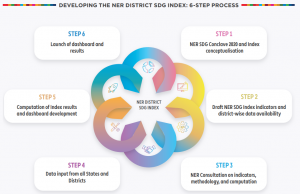
THE CONTEXT: Ministry of Education released the “Atal Ranking of Institutions on Innovation Achievements (ARIIA),” out of which Sevan Indian Institutes of Technology (IITs) have made it to the top 10.
THE EXPLANATION:
What is ARIIA?
Parameters:
THE CONTEXT: Following the two positive indigenization lists barring the import of 209 major platforms and systems, the Defence Ministry notified a list of another 2,500 subsystems and components and 351 more imported items to be made locally in the next three years.
THE EXPLANATION:
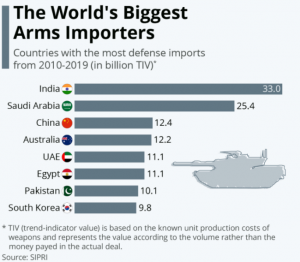
To reduce imports
Emerging technologies

THE CONTEXT: Ahead of the ongoing Rabi season, the Telangana government started crediting money into the bank accounts of eligible beneficiaries in the state.
THE EXPLANATION:
Under the Rythu Bandhu scheme, as many as 66.56 lakh farmers identified as beneficiaries, regardless of the extent of land owned by them, would receive financial assistance in 10 days.
With this, the state government would have disbursed Rs 50,405.63 crore to farmers under the scheme to date, a major landmark since its inception in May 2018.
What is Rythu Bandhu?
How does it compare with the PM-KISAN scheme?
The state government has often said that the Centre’s PM-KISAN (Pradhan Mantri Kisan Samman Nidhi) scheme is a “copy” of Rythu Bandhu. The Telangana government further claims that its own scheme is much better than PM-KISAN.
What about landless farmers?
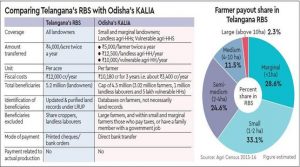
THE CONTEXT: An Israeli airstrike hit a shipment of Iranian weapons in the Syrian port of Latakia on 7th December 2021.
THE EXPLANATION:
Port of Latakia:
Significance:
Major ports in Syria:

|
Q1. With reference to the history of ancient India, Bhavabhuti, Hastimalla andKshemeshvara were famous – a) Jain monks b) Playwrights c) temple architects d) philosophers ANSWER FOR 29THDECEMBER 2021 Answer: D EXPLANATION: ACE2: Angiotensin-Converting Enzyme 2 The protein encoded by this gene belongs to the angiotensin-converting enzyme family of dipeptidyl carboxypeptidases and has considerable homology to the human angiotensin 1 converting enzyme. This secreted protein catalyzes the cleavage of angiotensin I into angiotensin 1-9, and angiotensin II into the vasodilator angiotensin1-7. ACE2 is known to be expressed in various human organs, and its organ- and cell-specific expression suggests that it may play a role in the regulation of cardiovascular and renal function, as well as fertility. In addition, the encoded protein is a functional receptor for the spike glycoprotein of the human coronavirus HCoV-NL63 and the human severe acute respiratory syndrome coronaviruses, SARS-CoVand SARS-CoV-2, the latter is the causative agent of coronavirus disease-2019(COVID-19). Multiple splice variants have been found for this gene and the dACE2(or MIRb-ACE2) splice variant has been found to be interferon inducible. |
THE CONTEXT: According to the report, Report on Trend and Progress of Banking in India 2020-21”, published by the RBI, which states that the banking sector managed to improve asset quality during the Covid year with the ratio of gross non-performing assets to advances declining from 8.2 per cent at March-end 2020 to 7.3 per cent at March-end 2021 — and further to 6.9 per cent at September-end 2021.
THE EXPLANATION:
LOAN RECOVERY VIA LOK ADALATS, IBC FALLS IN FY21
Trends on Banking frauds
Value Addition:
What is the difference between Loan Waiver and Loan Write-offs?
NPA Classification
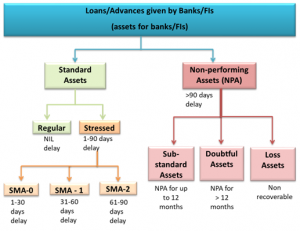
About Insolvency and Bankruptcy Code (IBC)
What is Lok Adalat?
THE CONTEXT: The Bihar forest department officials, caught six nilgais from the premises of Bihta Airport Station near Patna and sterilised them. They were taken to Valmiki Tiger Reserve in the state’s West Champaran district.
THE EXPLANATION:
What is the Issue?
About Nilgai:

Conservation Status:
What is Vermin?
Vermin means wild mammals and birds which are harmful to crops, farm animals or which carry disease. In India, wild animals can be declared as vermin if they have become (i) dangerous to human life or property (including standing crops on any land). (ii) become disabled or diseased as to be beyond recovery.
How are they declared?
THE CONTEXT: China launched the Ziyuan 1 (02E) Earth resources observation satellite and a small amateur radio satellite, marking the country’s 53rd orbital launch of the year.
THE EXPLANATION:

|
Some India’s earth observation satellites are:
|
THE CONTEXT: A new vulnerability named Log4 Shell is being touted as one of the worst cybersecurity flaws to have been discovered.
THE EXPLANATION:
Concerns:
Q1. The term ‘ACE2’ is talked about in the context of
a) genes introduced in genetically modified plants.
b) developments of India’s own satellite navigation system
c) radio collars for wildlife tracking
d) spread of viral diseases
ANSWER: D
EXPLANATION:
THE CONTEXT: NITI Aayog released the fourth edition of the State Health Index for 2019–20. The report, titled “Healthy States, Progressive India”, ranks states and Union Territories on their year-on-year incremental performance in health outcomes as well as their overall status.
THE EXPLANATION:
What are the indicators?
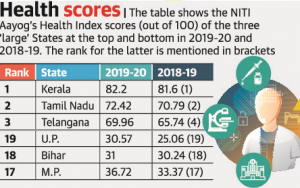
The Findings:
Among large states, Kerala and Tamil Nadu topped the list, and Telangana emerged strong on the third position in health outcomes and incremental performance. The state saw an improvement from the 4th position the last time — indicating that it has made strides in improving its health infrastructure by ensuring universal immunisation of children, setting up fully functional First Referral Units (FRUs) and all Primary Health Centres (PHCs) among others.
Among the ‘Larger States’, in terms of annual incremental performance, Uttar Pradesh, Assam and Telangana are the top three ranking states.
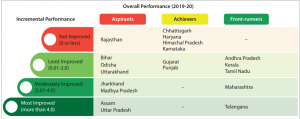
Among ‘Smaller States’, Mizoram and Meghalaya registered the maximum annual incremental progress.

Among UTs, Delhi, followed by Jammu and Kashmir, showed the best incremental performance.
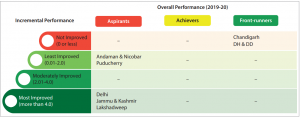
Key Points:
The Conclusion:
THE CONTEXT: In December 2021, the Centre told the Delhi High Court that the “right to be forgotten” is part of the fundamental right to privacy, but added it has no significant role to play in the matter. Petitions across courts have been seeking enforcement of this “right” — a legal principle that is not yet backed by statute in India.
THE EXPLANATION:

What is the right to be forgotten?
Which countries have such laws?
What is the position in India?
In a brief reply in one of the petitions earlier this week, the Centre told the Delhi High Court that the right to privacy has been recognised as a fundamental right in the K S Puttaswamy judgment (2017) and that the ‘right to be forgotten’ is evolving in India. The government said the Personal Data Protection Bill (a Joint Parliamentary Committee’s report on which was tabled on December 2021), contains provisions to the doctrine of the ‘right to be forgotten’.

When can the right be exercised?
In the right to privacy judgment, the Supreme Court had clarified that the recognition of this right “does not mean that all aspects of earlier existence are to be obliterated, as some may have a social ramification”.
The SC explained: “If we were to recognise a similar right, it would only mean that an individual who is no longer desirous of his personal data to be processed or stored, should be able to remove it from the system where the personal data/information is no longer necessary, relevant, or is incorrect and serves no legitimate interest.”
The apex court asserted that this right cannot be exercised where the information or data is necessary for:
CONCLUSION: Although the RTBF is a facet of the right to privacy, it has become very important in the digital age. The times when information is available at a click, the need to protect personal data becomes all the more important. Personal data such as related to matrimonial suits are of no relevance to the public. However, due to lack of proper legislation recognising this right people are subjected to harassment and loss of reputation. Therefore, legislation protecting this right is the need of the hour. Until then, the task is left to the judiciary which has to carefully tread its path between two fundamental rights- RTBF and freedom of expression.
THE CONTEXT: According to Union Home Ministry (MHA), the FCRA (Foreign Contribution Regulation Act) licence of Missionaries of Charity founded by Mother Teresa wasn’t renewed as some adverse inputs were received against it.
THE EXPLANATION:
Value Addition:
Foreign Contribution (Regulation) Act:
Foreign Contribution Regulation (Amendment) Rules 2020:
THE CONTEXT: According to the study published in ‘Environmental Science and Pollution Research, by the Aryabhatta Research Institute of Observational Sciences (ARIES) showed that reduction of economic activities during the pandemic-related lockdown had resulted in decrease of air pollution in most parts of India, but satellite observations show that parts of central-western India and north India showed an increase in pollution in contrast to the general trend.
THE EXPLANATION:

Value Addition:
The six common air pollutants are:
THE CONTEXT: In early December 2021, the import of Iranian kiwis from Afghanistan to India has posed a major concern for apple dealers in Kashmir following a contagious quarantine pest threat found.
THE EXPLANATION:

About Kashmir Apples:
National Plant Protection Organization (NPPO)
THE CONTEXT: According to the Department of Telecommunications (DoT) Delhi, Gurgaon, Mumbai, Bengaluru, Kolkata, Ahmedabad, Hyderabad, and Pune will be the first places to get 5G services next year i.e 2022.
THE EXPLANATION:
What is 5G technology and how is it different?
Where does India stand in the 5G technology race?

What is the global progress on 5G?

Q1. In the context of Colonial India, Shah Nawaz Khan, Prem Kumar Sehgal and Gurbaksh Singh Dhillon are remembered as:
a) leaders of Swadeshi and Boycott Movement
b) members of the Interim Government in 1946
c) members of the Drafting Committee in the Constituent Assembly
d) officers of the Indian National Army
ANSWER FOR 27TH DECEMBER 2021
ANSWER: D
EXPLANATION:
THE CONTEXT: Union Minister of Home Affairs released the Good Governance Index 2021 prepared by the Department of Administrative Reforms and Public Grievances (DARPG) on 25 December 2021 which is celebrated as Good Governance Day.
THE EXPLANATION:
Why December 25?
What is the Good Governance Index (GGI)?
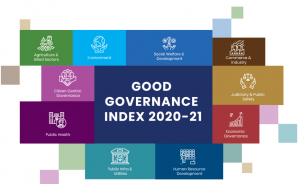
Further, the GGI 2020-21 categorizes States and UTs into four categories, i.e.,
With a “Citizen-Centric Administration” approach at the heart of the government’s Governance Model – this year, 20 States have improved their composite GGI scores over the GGI 2019 index scores.
Data Source:
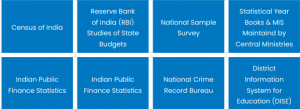
Top ranking States and UT’s
Analysis of the Index:
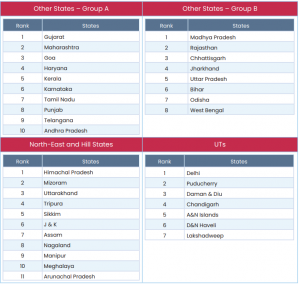
This GGI 2021 indicates that overall governance in the States of India is moving in a positive direction. The end results of these rankings are to improve citizen services and make the government inclusive and accountable.
THE CONTEXT: India has imposed anti-dumping duty on five Chinese products, including certain aluminium goods and some chemicals, for five years to guard local manufacturers from cheap imports from the neighbouring country.
THE EXPLANATION:
What is anti-dumping duty?
How is it different from Counter Vailing Duty?
THE CONTEXT: According to World Economic League Table report released by british consultancy CEBR predicted that China will become the world’s top economy in dollar terms in 2030, two years later than forecast in 2020.
THE EXPLANATION:
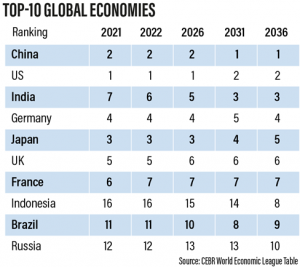
What is the current state of Indian economy?
India’s gross domestic product (GDP) at current prices stood at Rs. 51.23 lakh crore (US$ 694.93 billion) in the first quarter of FY22, as per the provisional estimates of gross domestic product for the first quarter of 2021-22.

THE CONTEXT: NASA’s James Webb Space Telescope (JWST) was launched successfully from the European Space Agency’s (ESA) launch base in French Guiana.
THE EXPLANATION:
About James Webb Space Telescope (JWST or Webb)
JWST is an engineering marvel comparable to the earth-based Event Horizon Telescope that produced the photograph of the black hole, or the LIGO that detected the gravitational waves. It is widely expected to unveil many secrets of the universe, particularly those related to the formation of stars and galaxies in the early period — the first few hundred million years — after the Big Bang.

Objectives and functions of the telescope:
Where it is placed?
The James Webb Space Telescope will not be in orbit around the Earth, like the Hubble Space Telescope is – it will actually orbit the Sun, 1.5 million kilometres (1 million miles) away from the Earth at what is called the second Lagrange point or L2.
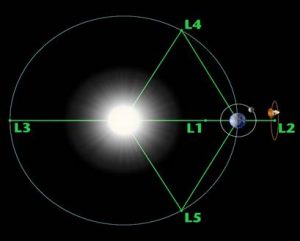
THE CONTEXT: Researchers at Karolinska Institute in Sweden have found that negative smells associated with unpleasantness or unease are processed earlier than positive smells and trigger a physical avoidance response.
THE EXPLANATION:
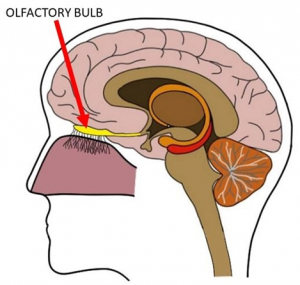
The cognitive process is not only unconscious but is also extremely rapid, this goes against the conventional wisdom that unpleasant smells associated with danger is a conscious cognitive process.
What are Olfactory Bulbs?
A rounded mass of tissue that contains several types of nerve cells that are involved in the sense of smell. The olfactory bulbs receive information about smells from the nose and send it to the brain by way of the olfactory tracts.
THE CONTEXT: Telangana stood first in the implementation of the Shyama Prasad Mukherji Rurban Mission (SPMRM) that was launched in 2016, to stimulate local economic development, enhance basic services and create well planned clusters.
THE EXPLANATION:
“The establishment of a bulk milk chilling unit at Narayanakhed had benefited about 3,500 farmers, income ranging between ₹50,000 and ₹2.5 lakh per annum, depending on the number of milch animals. A plastic waste treatment unit and millet processing unit are also coming up at Ryakal cluster,”
Value Addition:
SHYAMA PRASAD MUKHERJI RURBAN MISSION (SPMRM)- NATIONAL RURBAN MISSION (NRUM)
Objective
The objective of the National Rurban Mission (NRuM) is to stimulate local economic development, enhance basic services, and create well planned Rurban clusters. It is established in 2016 as a centrally sponsored scheme, and it comes under the Ministry of Rural Development.
Outcomes
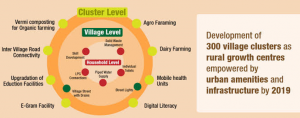
Rurban Cluster
A ‘Rurban cluster’, would be a cluster of geographically contiguous villages with a population of about 25000 to 50000 in plain and coastal areas and with a population of 5000 to 15000 in desert, hilly or tribal areas. As far as practicable, clusters of villages would follow administrative convergence units of Gram Panchayats and shall be within a single block/tehsil for administrative convenience.
Q1. ‘Triclosan’, considered harmful when exposed to high levels for a long time, is most likely present in which of the following?
a) Food preservatives b) Fruit-ripening substances
c) Reused plastic containers d) Toiletries
Answer: d)
Explanation:
THE CONTEXT: In a bid to cool down the domestic prices of Soya Meal, Government has notified an Order under the Essential Commodities Act to declare ‘Soya Meal’ as an Essential Commodities up to 30th June 2022 by amending the Schedule of the Essential Commodities Act, 1955.
THE EXPLANATION:
According to the ministry, the following stock limits have been promulgated of all Soya meal for a period upto 30 June 2022 with following stock limits for all States and Union Territories:
What is meant by the Essential Commodity Act?
The Act gives powers to the central government to add or remove a commodity in the “Schedule.” The Centre, if it is satisfied that it is necessary to do so in public interest, can notify an item as essential, in consultation with state governments.
At present, the “Schedule” contains 9 commodities — drugs; fertilisers, whether inorganic, organic or mixed; foodstuffs, including edible oils; hank yarn made wholly from cotton; petroleum and petroleum products; raw jute and jute textiles; seeds of food-crops and seeds of fruits and vegetables, seeds of cattle fodder, jute seed, cotton seed; face masks; and hand sanitisers.
How and under what circumstances can the government impose stock limits?
THE CONTEXT: According to the report published in the British Medical Journal November 2021 Observed that life expectancy in 2020 reduced in 29 of the 37 countries surveyed compared to the expected figures, decreased by 1.1-2.3 years for men and 1.1-2.1 years for women.
THE EXPLANATION:
THE CONTEXT: According to the RBI deputy Governor, India’s monetary policy is by design financially inclusive, the evidence of which is still coalescing, and increased inclusion will over time enhance policy effectiveness by fostering societal intolerance to inflation.
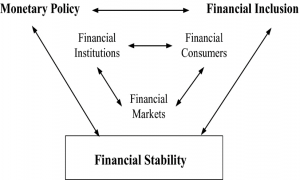
THE EXPLANATION:
Price stability target

THE CONTEXT: According to International Energy Agency (IEA), Carbon emissions from coal will be 3 gigatonnes higher in 2024 than required to achieve Net Zero emissions by 2050.
THE EXPLANATION:
Coal was in focus at the 26th Conference of Parties (COP 26) to the United Nations Framework Convention on Climate Change in Glasgow November 2021. “Cash, coal, cars and trees” was the marketing term used by United Kingdom Prime Minister to capture the UK’s strategy at the summit.
Net Zero Commitment:
India’s Picture:
At the same time, the co-benefits of transitioning to a zero-carbon energy system as soon as possible are undeniable. And the Union government’s domestic efforts do not echo its global statements.
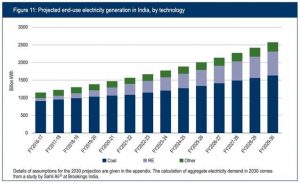
THE CONTEXT: The Defense Research and Development Organization (DRDO) successfully carried out the maiden test of ‘Pralay’, a new surface-to-surface conventional quasi-ballistic missile, in a boost for India’s tactical battlefield strategy.
THE EXPLANATION:
Significance:
‘Change tactical battlefield dynamics’
THE CONTEXT: INS Sudarshini is presently on its culmination phase of deployment to Gulf region as part of Indian Navy’s efforts towards familiarising friendly foreign navies on various facets of operations and training on board sail training platforms and extending ‘Bridges of Friendship’.
THE EXPLANATION:

PLACES IN NEWS:
IMPORTANCE OF BANDAR ABBAS
1. Consider the following statements about Election Commission:
Which of the statements given above is/are incorrect?
a) 1 only b) 1 and 2 only
c) 2 and 3 only d) All of them
Answer: a)
Explanation:
Eligibility criteria:
THE CONTEXT: Maharashtra is the second state in India after Andhra Pradesh to approve the death penalty for heinous offences of rapes and gang-rapes, with the Maharashtra Assembly unanimously passing the Shakti Criminal Laws (Maharashtra Amendment) Bill.
THE EXPLANATION:
Add to your Knowledge:

THE CONTEXT: South Korea has become the 10th country outside of Europe to join the European Union (EU) law enforcement cooperation agency that fights terrorism and other international crimes.
WHAT IS EUROPOL?
Europol is the European Union’s law enforcement agency. Their main goal is to achieve a safer Europe for the benefit of all the EU citizens. It is established in 1992 and its headquarter is in The Hague, the Netherlands, we support the 27 EU Member States in their fight against terrorism, cybercrime and other serious and organized forms of crime.
Large-scale criminal and terrorist networks pose a significant threat to the internal security of the EU and to the safety and livelihood of its people. The biggest security threats come from:
The networks behind the crimes in each of these areas are quick to seize new opportunities, and they are resilient in the face of traditional law enforcement measures.
However, EUROPOL has no executive powers. The officials of EUROPOL cannot arrest the suspects without prior approval from competent authorities.
Under the agreement, police can now exchange information on crime and cooperate with member states of EUROPOL 17 European and nine non-European countries as well as international organizations and research institutes collaborating with the agency.
Who are the other 9 Non- EU members?
India and EUROPOL:
In the year 2020, India-EU Strategic Partnership: A Roadmap to 2025 was held, during the summit between India and the EU talked about implementing a working arrangement between Europol and the Central Bureau of Investigation (CBI).
THE CONTEXT: The eyeless, subterranean creature with 1,306 legs discovered 60 meters underground is the first ‘true millipede’.
THE EXPLANATION:
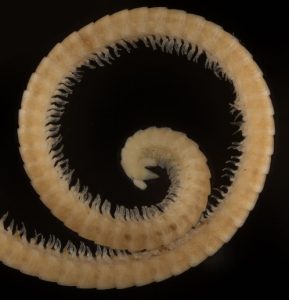
Finding unknown
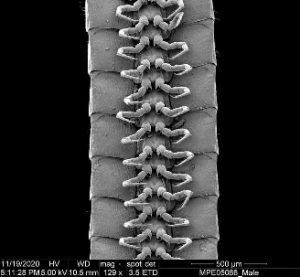
THE CONTEXT: Scientists have resumed tagging of Olive Ridley turtles at Rushikulya rookery along the Odisha coast, which would help them identify the migration path and places visited by the marine reptiles after congregation and nesting.
THE EXPLANATION:
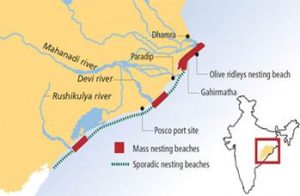
Mass Tagging:
Olive Ridley Sea Turtles
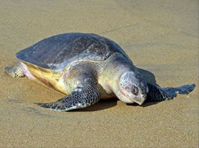
Developed by: The application has been developed by the Indian Turtle Conservation Action Network(ITCAN) in collaboration with the Turtle Survival Alliance-India and Wildlife Conservation Society-India.
THE CONTEXT: DRDO successfully conducted the flight test of Indigenously developed High-speed Expendable Aerial Target (HEAT) Abhyas from Integrated Test Range (ITR), Chandipur off the coast, Odisha.
THE EXPLANATION:
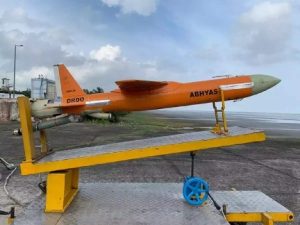
THE PRELIM PRACTICE QUESTION
1. Who among the following are eligible beneficiaries under Pradhan Mantri Ujjwala Yojana(PMUY)?
Select the correct answer using the code given below:
a) 1 and 2 only
b) 2 and 3 only
c) 1 and 3 only
d) All of them
ANSWER FOR 23rd DECEMBER 2021
Answer: a)
Explanation:
THE CONTEXT: The winter session of Parliament ended the same way it started on November 29,2021 — on an acrimonious note. Both Houses have adjourned sine die a day ahead of schedule.
THE EXPLANATION:
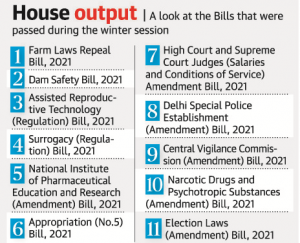
Sessions of Parliament
Summoning of the Parliament is specified in Article 85 of the constitution.
The power to convene a session of Parliament rests with the government. The decision is taken by the Cabinet Committee on Parliamentary Affairs. The decision of the Committee is formalized by the President, in whose name MPs are summoned to meet for a session.
There are usually three sessions in a year, viz,
Also, every year the session starts with the Presidential address.
Adjournment:
Adjournment sine die:
Adjournment sine die refers to the termination of a sitting of the House without any definite date being fixed for the next sitting.
Prorogation:
Dissolution:
THE CONTEXT: The Karnataka Protection of Right to Freedom of Religion Bill, 2021 introduced in the Karnataka Assembly aims to prohibit conversion by misrepresentation, force, fraud, the allurement of marriage, coercion and undue influence.
THE PROVISIONS OF THE BILL:
About conversion, the Bill claims that “allurement” includes any offer of any temptation in the form of:

How has Parliament handled anti-conversion bills?
THE CONTEXT: According to the Monthly Progress Report on Forest Rights Acts, published by the Ministry of Tribal Affairs (MoTA), Government of India, only 14.75% of the minimum potential forest areas for forest rights in India has been recognized since the Act came into force.
THE ANALYSIS OF THE FOREST RIGHTS ACT

IFR = Individual Forest Rights and CFR = Community Forest Rights
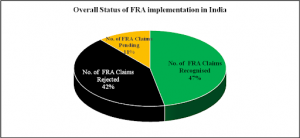
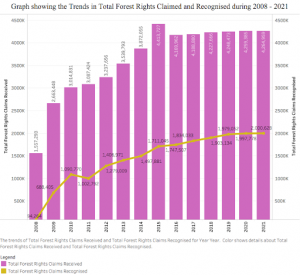
Enforcement challenges
MYTHS ABOUT FRA
Way forward
THE BACKGROUND:
About Forest Rights Act 2006:
Provisions of the 2006 Act
Features of the Act
The act identifies four types of rights:
Title rights
Use rights
Relief and development rights
Forest management rights
THE CONTEXT: The Cabinet Committee on Economic Affairs chaired by the Prime Minister has given its approval for the Minimum Support Prices (MSPs) for copra for the 2022 season.
THE EXPLANATION:
According to the statement released by the Government,

VALUE ADDITION:
What is the Minimum Support Price:

Commission for Agricultural Costs and Prices (CACP)
NAFED
THE CONTEXT: Digital payment firms and merchant bodies have petitioned the Reserve Bank of India to extend the deadline for implementation of the new credit and debit card data storage norms, or card-on-file tokenization (CoF). The RBI mandate on tokenization kicks in from January 1, 2022.
THE EXPLANATION:
WHAT IS TOKENISATION?
Challenges with the process
E-commerce platforms, online service providers and small merchants
Significance:

THE CONTEXT: Forest officials from Sirnapalli forest in Telangana spotted a rare Albino flap shell species, researchers later suggested they were traced only twice before in 2020 — once in Odisha and then in West Bengal,
THE EXPLANATION:
About Indian Flapshell turtle
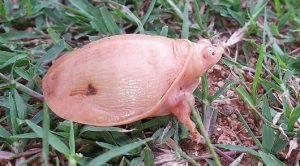
Threat: Exploitation on for-profit and habitat change are threats to their survival.
|
Add to your Knowledge: SC: Possession of ‘Indian Flap Shell Turtle’ not an offence under the Wildlife Protection Act SC said that the Turtle which has been seized is not that which is included in Part II of Schedule I. It stated that the Veterinary Surgeon has identified the Turtle as ‘Indian Flap Shell (Lissemy’s Punctata)’ whereas the Turtle which is included in Part II of Schedule I of the Act, 1972 is “Indian Soft-shelled Turtle (Lissemys punctata punctata).” |
THE PRELIM PRACTICE QUESTION
1. Consider the following statements:
Which of the given statements is/are correct?
a) 1 only
b) 2 only
c) Both 1 and 2
d) Neither 1 nor 2
FOR 22TH DECEMBER 2021 PRELIMS PRACTICE QUESTIONS
Answer: c)
Explanation:
Statement 1 is correct: In 2021, India was ranked 142nd out of 180 countries, placed in ‘bad category.
THE CONTEXT: Nagaland government has created three new districts in the state, taking the total number of districts to 15.
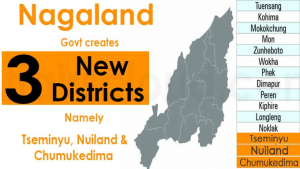
THE EXPLANATION:
How are new districts carved?
The power to create new districts or alter or abolish existing districts rests with the State governments. This can either be done through an executive order or by passing a law in the State Assembly. The many States prefer the executive route by simply issuing a notification in the official gazette.
How does it help?
States argue that smaller districts lead to better administration and governance. For example, in 2016, the Assam government issued a notification to upgrade the Majuli sub-division to Majuli district for “administrative expediency”.bdivision under Kohima district, Nagaland,” read a notification issued by the Nagaland government.
Does the Central government have a role to play here?
The Centre has no role to play in the alteration of districts or the creation of new ones. States are free to decide. The Home Ministry comes into the picture when a State wants to change the name of a district or a railway station. The State government’s request is sent to other departments and agencies such as the Ministry of Earth Sciences, Intelligence Bureau, Department of Posts, Geographical Survey of India Sciences and the Railway Ministry seeking clearance. A no-objection certificate may be issued after examining their replies.
What has been the trend?
According to the 2011 Census, there were 593 districts in the country. The Census results showed that between 2001-2011, as many as 46 districts were created by States. Though the 2021 Census is yet to happen, Know India, a website run by the Government of India, says currently there are 718 districts in the country. The surge in number is also due to the bifurcation of Andhra Pradesh into A.P and Telangana in 2014. Telangana at present has 33 districts and A.P has 13 districts.
THE CONTEXT: Underlining that the humanitarian crisis in Syria has not seen significant improvement in recent months, India has called for a nationwide comprehensive ceasefire, saying doing so will help to expand crossline humanitarian aid operations in the country.
THE EXPLANATION:

THE BACKGROUND
Syria is a west Asian Country bordering Lebanon, Turkey, Iraq, Jordan, and Israel. The civil war in Syria is regarded as the most brutal conflict in the world which started off in 2011.
The conflict between Shia Islam and Sunni Islam
The root of this conflict can be traced to sectarian conflicts in the region existing there for centuries. Shia Islam and Sunni Islam are the two major denominations of Islam Religion. With Saudi Arabia regarding itself as the leader of Sunni Muslims and Iran as the protector of Shia Muslims, the West Asian region is divided under these two leaders. Saudi and Iran started playing an important role in the geopolitical conflicts in the region.
What caused the uprising?
While lack of freedoms and economic woes drove resentment of the Syrian government, the harsh crackdown on protesters inflamed public anger.
Who are Kurds?
Why is Turkey invading Syria?
By invading northern Syria, Turkey seeks to create a peace zone, where it can deport Syrian refugees that fled the country during the Civil war in Syria.
However, experts believe in the name of the creation of a peace zone, Turkey wants to land grab the strategic area.
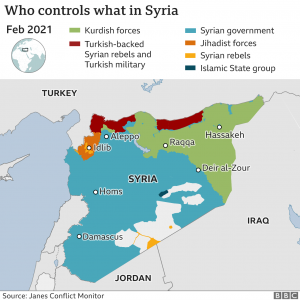
|
The Way ahead:
The outside powers that are involved in Syria’s civil war through proxy means need to reconsider their decision. Their role in converting a peaceful democratic movement into full-fledged war should be condemned. They should stop financing the extremist groups to avoid further conflicts in the region.
Considering the large-scale devastation which happened in Syria, rebuilding its human and social capital will be an insurmountable task for the govt. Therefore, the international community should come forward with a helping hand to bring the war-torn nation into normalcy. India can also play a constructive humanitarian role to establish peace and stability in the region.
THE CONTEXT: The Union Ministry of Agriculture and Farmers Welfare notified the draft order on ‘Prohibition of Streptomycin + Tetracycline in agriculture’, which prohibits import, manufacture or formulation of Streptomycin and Tetracycline for use in agriculture from February 1, 2022.
THE EXPLANATION:
Empirical data
What is antimicrobial resistance?

For example:
Colistin is the only last resort treatment for life-threatening infections caused by carbapenem-resistant Enterobacteriaceae (i.e. E.coli, Klebsiella, etc). Bacteria resistant to colistin have also been detected in several countries and regions, causing infections for which there is no effective antibiotic treatment at present.
KEY FACTS
|
THE CONTEXT: Forest officials from Sirnapalli forest in Telangana spotted a rare Albino flap shell species, researchers later suggested they were traced only twice before in 2020 — once in Odisha and then in West Bengal,
THE EXPLANATION:
About Indian Flapshell turtle
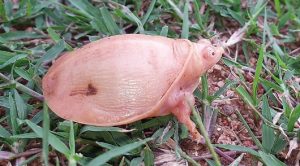
Threat: Exploitation on for-profit and habitat change are threats to their survival.
|
Add to your Knowledge: SC: Possession of ‘Indian Flap Shell Turtle’ not an offense under the Wildlife Protection Act SC said that the Turtle which has been seized is not that which is included in Part II of Schedule I. It stated that the Veterinary Surgeon has identified the Turtle as ‘Indian Flap Shell (Lissemy’s Punctata)’ whereas the Turtle which is included in Part II of Schedule I of the Act, 1972 is “Indian Soft-shelled Turtle (Lissemys punctate).” |
THE CONTEXT: Prime Minister launched the UDAN scheme nearly five years back with the aim to take flying to the masses. While over 400 routes have been launched by airlines, some of them have been discontinued.
THE EXPLANATION:
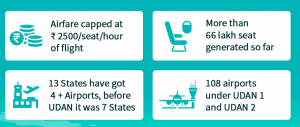
What is UDAN Scheme:
What is the status of the scheme?
What have been the challenges?
What lies ahead for the scheme?
The Government offers subsidies for a route for a period of three years and expects the airline to develop the route during this time so that it becomes self-sufficient.
THE PRELIM PRACTICE QUESTION
1. Consider the following statements about World Press Freedom Index:
Which of the statements given above is/are correct?
a) 1 only
b) 2 only
c) Both 1 and 2
d) Neither 1 nor 2
THE CONTEXT: The number of Assembly constituencies in Jammu will increase by six and in Kashmir by one, according to the draft paper of the Delimitation Commission. For the first time, the commission proposed reserving nine seats for Scheduled Tribes on the basis of population. Seven seats are proposed for the Scheduled Caste community. An additional 24 seats are proposed to be reserved for Pakistan-occupied Kashmir.
THE EXPLANATION:

What is Delimitation?
Aim: The key aim is to have equal representation to equal segments of the population in order to ensure a fair division of geographical areas so that all political parties or candidates contesting elections have a level playing field in terms of the number of voters.
Constitutional provisions:
Delimitation Commission
THE CONTEXT: Recently, PANEX-21was held in Pune for Humanitarian Assistance and Disaster Relief Exercise is to be held among the BIMSTEC countries: Bhutan, Bangladesh, Nepal, Myanmar, Sri Lanka, India and Thailand. The main aim of the exercise is to build regional cooperation in responding to natural disasters.
About PANEX-21:
How will the exercise be conducted?
Why is the exercise important?
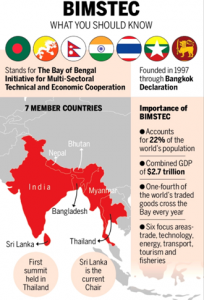
Why is BIMSTEC important for India?
As the region’s largest economy, India has a lot at stake.
THE CONTEXT: According to the new report, India recorded 867,000 deaths in 2017 due to exposure to fine particulate matter (PM2.5) — the second highest in the world.
THE EXPLANATION:
Major Pollutants:
Value Addition:
What is PM 2.5 and PM 10?
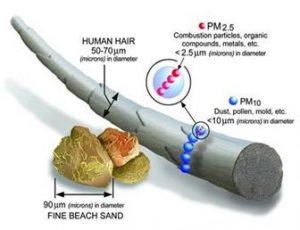
Sources of Particulate Matter
What are the health effects of PM2.5 and PM10?
Government Measurements:
THE CONTEXT: The study was undertaken as part of an assessment of the environmentally sensitive areas within the framework of the UN Convention to Combat Desertification (UNCCD). The scientists associated with the project studied the climate and vegetation in Thar, which is the world’s ninth-largest hot subtropical desert, to understand the desertification process.
THE EXPLANATION:
LOSS OF ARAVALI’S
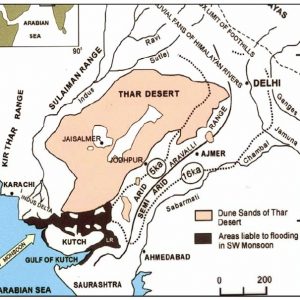
About the Thar Desert:
The Thar Desert is about 4.56% of the total geographic area of India. More than 60% of the desert lies in the Indian state of Rajasthan; the portion in India also extends into Gujarat, Punjab, and Haryana.
UN Convention to Combat Desertification (UNCCD):
COP14
OUTCOMES:
Delhi Declaration: Commitment for a range of issues, including gender and health, ecosystem restoration, taking action on climate change, private sector engagement, Peace Forest Initiative and recovery of five million hectares of degraded land in India.
The country parties have agreed to make the Sustainable Development Goal target of achieving land degradation neutrality by 2030, a national target for action.
Peace Forest Initiative: It is an initiative of South Korea to use ecological restoration as a peace-building process. It aims at addressing the issue of land degradation in conflict-torn border areas and would go a long way in alleviating tensions and building trust between communities living there and between enemy countries in particular.
The Bonn Challenge is a global effort to bring 150 million hectares of the world’s deforested and degraded land under restoration by 2020, and 350 million hectares by 2030.
THE CONTEXT: Heavy rains across Karnataka during October and November 2021 have affected the winter migration of birds that otherwise used to flock in large numbers and roost in the water bodies of the State before flying out again during the onset of summer.
THE EXPLANATION:
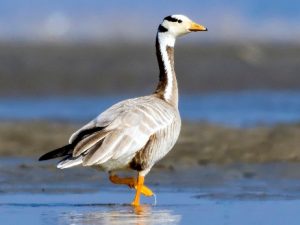
THE CONTEXT: An Indian desert cat has been spotted for the first time in Madhya Pradesh’s Panna Tiger Reserve (PTR).
THE EXPLANATION:
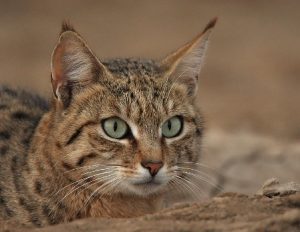
About Indian Desert Cat
Threats and Conservation:
About Panna Tiger Reserve
UNESCO on Panna Biosphere Reserve
THE PRELIM PRACTICE QUESTION
Q1. Consider the following statements about OIC:
Which of the above statements is/are correct?
a) 1 only
b) 2 and 3 only
c) 1 and 3 only
d) All of them
FOR 19TH DECEMBER 2021 PRELIMS PRACTICE QUESTIONS
Answer: A)
Explanation:
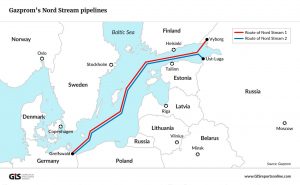
THE CONTEXT: The 3rd meeting of the India-Central Asia Dialogue was held under the chairmanship of the External Affairs Minister of India. Ministers of Foreign Affairs of the Republic of Kazakhstan, Kyrgyz Republic, Republic of Tajikistan, Turkmenistan, and the Republic of Uzbekistan took part in the meeting.
IMPORTANT OUTCOMES OF THE MEETING
During Pandemic:
INSTC Corridor:
INSTC CORRIDOR
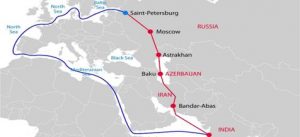
Defence and Security:
Afghan Crisis:
Climate Change:
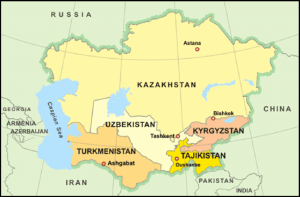
THE CONTEXT: According to researchers, with its size, population and aggravating air pollution, India needs 1,600 to 4,000 air quality monitors but has only 804 as of September 2021, most of which are concentrated in urban areas.
THE EXPLANATION:
Real-time monitoring
There are 261 real-time monitors whose data are updated on the central database. This network is technically part of the National Air Quality Monitoring Programme but its data are stored and treated separately because Central Pollution Control Board has not established a method of equivalence between the two monitoring techniques, the 2020 Centre for Science and Environment report pointed out.
Monitoring stations needed
Measuring pollutants
Value Addition:
National Air Quality Index (AQI)
Six AQI categories
|
AQI |
Associated Health Impacts |
|
Good |
Minimal Impact |
|
Satisfactory |
May cause minor breathing discomfort to sensitive people. |
|
Moderately polluted |
May cause breathing discomfort to people with lung disease such as asthma, and discomfort to people with heart disease, children and older adults. |
|
Poor |
May cause breathing discomfort to people on prolonged exposure, and discomfort to people with heart disease |
|
Very Poor |
May cause respiratory illness to the people on prolonged exposure. The effect may be more pronounced in people with lung and heart diseases. |
|
Severe |
May cause respiratory impact even on healthy people, and serious health impacts on people with lung/heart disease. The health impacts may be experienced even during light physical activity. |
Centre-run System of Air Quality and Weather Forecasting and Research (SAFAR)
Government Measurements:
THE CONTEXT: After successfully reintroducing the critically endangered Gharial (Gavialis Gangeticus) in the rivers of Punjab where it had become extinct half a century ago, the State’s wildlife preservation wing is now keeping its fingers crossed, expecting the breeding of the crocodilians to start in the new few years as the released gharials are healthy and have adapted to the Beas Conservation Reserve as their home.
THE EXPLANATION:
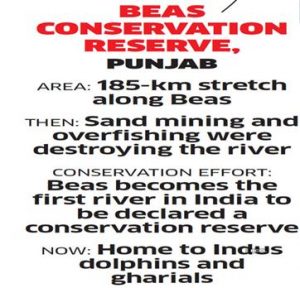
Value Addition:
Habitat and Distribution
THE CONTEXT: Defence Research and Development Organisation (DRDO) successfully tested the new generation nuclear capable ballistic missile ‘Agni P’ from Dr APJ Abdul Kalam island off the coast of Odisha.
THE EXPLANATION:
About Agni-V
Agni-V is an Indian nuclear-capable intercontinental ballistic missile (ICBM). It has been developed by the Defence Research and Development Organisation. Missile is having a range of around 5000 to 8000 km. It is a three-stage, solid-fuelled and road-mobile intercontinental ballistic missile. It is transported by a truck and launched using a canister.
Significance of Agni V
Agni V is used to enhance India’s nuclear deterrence against China. Earlier, the longest-range missile in India was Agni-III, which had the range of 3000–3500 km. This range was not sufficient to reach targets eastern and north-eastern region of China. Thus, DRDO was working on the upgraded version of this missile called Agni-V.
What is Ballistic Missile?
Types of ballistic missiles based on the range
What is the difference between ballistic and cruise missiles
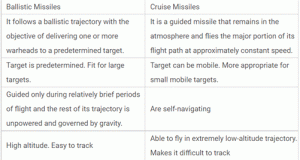
THE PRELIM PRACTICE QUESTION
Q1. ‘Nord Stream’ sometimes seen in the news is a natural gas pipeline between which of the following countries?
A) Russia and Germany
B) Germany and U.K.
C) K. and France
D) Germany and Sweden
FOR 18TH DECEMBER 2021 PRELIMS PRACTICE QUESTIONS
Answer: B
Explanation:
Statement 2 is correct: It consists of a chairperson and 6 Members.
THE CONTEXT: The third Annual Defence Dialogue between India and France took place between Defence Minister and his French counterpart in New Delhi. A wide range of bilateral, regional, defence and defence industrial cooperation issues were discussed in the annual meeting.
THE EXPLANATION:
France’s resolve to expand strategic cooperation with India came nearly two months after the unveiling of a new security alliance (AUKUS) by Australia, the UK and the US that had infuriated the French government.
Defence & Space Cooperation between the two countries
THE CONTEXT: The India Meteorological Department (IMD) has predicted a cold wave in parts of Punjab, Haryana, Chandigarh, Gujarat, Rajasthan, and Uttar Pradesh from mid-December 2021.
THE EXPLANATION:
What is a cold wave?
The IMD defines a cold wave qualitatively as “a condition of air temperature which becomes fatal to the human body when exposed.”
Why do cold waves occur?
How is it measured?
THE CONTEXT: Recently, Arctic Report Card was published by the Arctic Program of the National Oceanic and Atmospheric Administration where it stated that “the COVID-19 pandemic has exacerbated existing challenges for Alaska natives in accessing traditional foods”.
THE EXPLANATION:


Value Addition:
What is the Arctic Council?
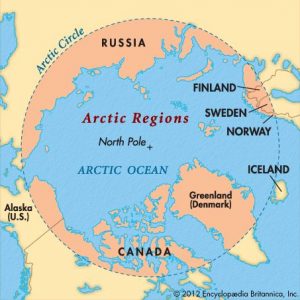
India and Arctic
THE CONTEXT: The launch of the US-India Climate and Clean Energy Agenda 2030 partnership in April 2021 reiterated the commitment of both nations to work together to achieve their ambitious climate and clean energy targets and to strengthen bilateral collaborations.
THE EXPLANATION:
What is the need?
ADD TO YOUR KNOWLEDGE
The US’s special envoy for climate action, visited India in April 2021 to discuss climate finance and action under the bilateral Climate and Clean Energy Agenda 2030Partnership. The partnership, launched in April 2021, aims to provide financial and technological support to India to meet its Paris Agreement goals on transitioning to renewable energy by 2030
Partnership to Advance Clean Energy (PACE)
Q1. Consider the following statements:
Which of the statements given above is/are correct?
a) 1 only
b) 2 only
c) Both 1 and 2
d) Neither 1 nor 2
FOR 17TH DECEMBER 2021 PRELIMS PRACTICE QUESTIONS
Answer: c)
Explanation:
Answer: b)
Explanation:
Blue box subsidies:
THE CONTEXT:According to the Ministry of Culture, the Chalcolithic cultures of Central India are adequately investigated and studied. Much of their aspects are sufficiently researched and analyzed.
THE EXPLANATION:
During field season 2021-22, ASI has received proposals for excavations at the sites of Chalcolithic affiliations at Eran, district Sagar and at Tewar, district Jabalpur of Madhya Pradesh.
Status of Archaeological Investigations in Central India
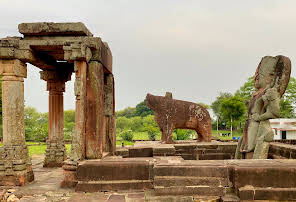
Excavation at Eran during 2020-21: Eran (ancient Airikina) is situated on the left bank of the Bina (ancient Venva) river and surrounded by it on three sides. Eran is located 75 km north-west from Sagar district headquarter.
Excavation at Tewar during 2020-21:Tewar (Tripuri) village is located 12 km west of Jabalpur district on Jabalpur – Bhopal highway. The ancient site of Tripuri is situated nearly 2 km south west from Tewar village. During 2020-21 ASI conducted excavation of Tewar at two locations, TWR 1 and TWR 2.
VALUE ADDITION:
The term Chalcolithic is a combination of two words- Chalco+Lithic is an archaeological period that is usually considered to be part of the broader Neolithic (although it was originally defined as a transition between the Neolithic and the Bronze Age).
Important Sites Chalcolithic Culture
| Chalcolithic Culture |
Sites of Chalcolithic Culture |
| 1. Ahara Culture | Aahar (Rajasthan), balathal, Gilund etc. The distinctive feature is black and red ware. |
| 2. Kayatha Culture | Located in Chambal and its tributaries, the sturdy red slipped ware with chocolate designs is main feature. |
| 3. Malwa Culture | Narmada & its tributaries in Gujarat. One of the largest Chalcolithic settlements. |
| 4. Svalda Culture | Dhulia district of Maharashtra. |
| 5. Prabhas & Rangpur Culture | Both of them are derived from the Harappa culture. The polished red ware is the hall mark of this culture. |
Characteristics of Chalcolithic Age
(a) People of Chalcolithic Age survived on hunting, fishing, and farming
(b) Hunting was one of the important occupations
(c) Animals such as sheep, buffalo, goat, cattle, and pig were reared and killed for food
(d) Remains of camels are also found. People ate beef but no traces of eating pork are found
(e) People of Navdatoli grew ber and linseed
(f) Cotton was produced in black cotton soil
(g) Traces of rice cultivation are also found. This shows that their food included fish and rice. Eastern India produced rice and Western India produced barley
(h) The major crops cultivated were barley and wheat, lentil, bajra, jowar, ragi millets, green pea, green and black gram
(a) Metals such as copper and its alloys were used to make knives, axes, fishing hooks, chisels, pins, and rods
(a) Use of bricks was extensive during the Chalcolithic people of Harappa but there are no traces of burnt (baked) bricks.
(b) The planning of the houses was simple which was either rectangular or circular.
(c) The walls of houses were made from mud and plastered with cow dung and lime.
(d) The houses mostly had only one room, but sometimes multi-roomed houses were also seen.
(e) For influential people, large mud houses with 5 rooms, 4 rectangular and 1 circular in centre of the settlement are found.
(f) In inamgaon, ovens and circular pit houses are found.
THE CONTEXT: The country commemorated 50 years of the decisive victory in the 1971 Liberation War of Bangladesh, which also changed the geography of South Asia.
THE EXPLANATION:
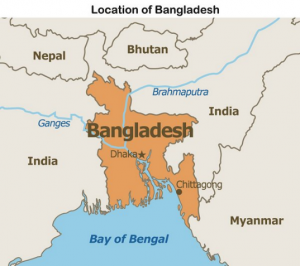

What were the causes of 1971 war?
THE CONTEXT: Natural disasters such as cyclones and floods have increased in the country and the Arsenic in groundwater beyond the permissible limit has been encountered in three districts in Punjab.
THE EXPLANATION:
Frequency of natural disasters
Heavy metals in groundwater
According to the data available with Central Ground Water Board, As of December 13, 2021, 36,873 rural habitations were reported to have quality issues in drinking water sources.
Arsenic in groundwater beyond the permissible limit has been encountered in three districts in Punjab, particularly in Malwa belt Mansa, Faridkot and Sangrur;
Old dams
India has 1,175 large dams (including one dam of Punjab, Nangal dam) more than 50 years old (constructed in or before 1971), according to the National Register of Large Dams (2019) maintained by the Central Water Commission.
The country has 227 large dams having more than 100 years of service life (constructed in or before 1921).
Cost economics of renewable energy sources
Encroachment of water bodies
According to the Ministry of Jal Shakthi, the works related to the enumeration of water bodies, their protection from encroachment or diversion for use for other purposes, comes under the purview of the state government concerned. However, from time to time, the Union Ministry of Jal Shakti conducts census of minor irrigation schemes in the country, which captures data regarding water bodies in rural areas associated with irrigation.
There are 516,303 water bodies in the rural areas of the country being used for minor irrigation purposes, out of which 53,396 are not in use for various reasons such as non-availability of water, siltation, salinity, etc.
THE CONTEXT: The Union Cabinet took the decision to raise the legal age of marriage for women from 18 to 21 years. The legal age of marriage for men is 21 years. With this decision, the government will be bringing the age of marriage for both men and women at par.
THE EXPLANATION:
Why is there a minimum age of marriage?
Why has the government decided to re-examine the age of marriage?
What is the Jaya Jaitly committee?
What did the committee recommend?
THE CONTEXT: According to the report, there are currently 488 media professionals imprisoned around the world,the highest number since Reporters Without Borders began counting more than 25 years ago.
THE EXPLANATION:
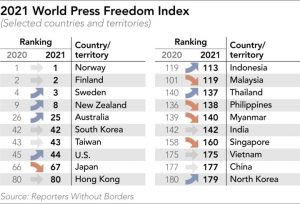
WORLD PRESS REPORT 2021
India is ranked 142, same as in 2020, after it had consistently slid down from 133 in 2016. In the South Asian neighbourhood, Nepal is at 106, Sri Lanka at 127, Myanmar (before the coup) at 140, Pakistan at 145 and Bangladesh at 152.
About World Press Freedom Index:
THE CONTEXT: Researchers from Mishmi hills of Arunachal Pradesh sighted a rare species of Butterfly, which is first documented in 20 years ago.
THE EXPLANATION:

Since the Huang’s Mystic Lethe wui Huang has not been reported in India until now, it is not safeguarded by the country’s Wildlife (Protection) Act unlike several other species of butterflies.
Butterfly festivals
THE PRELIM PRACTICE QUESTION
Q1. Minimum Support Prices (MSP) for agricultural products comes under which of the following box of WTO?
a) Blue box
b) Green box
c) Amber box
d) S & D box
Q2. In the context of the WTO, the subsidies tied to programmes that limit production are known as-
a) Amber box subsidies
b) Blue box subsidies
c) Green box subsidies
d) S & D box subsidies
FOR 16TH DECEMBER 2021 PRELIMS PRACTICE QUESTIONS
Answer: D)
Explanation:
THE CONTEXT: Durga Puja in Kolkata, one of largest cultural carnivals and street art festival of the country, received an important international recognition by making it to UNESCO’s Representative List of the Intangible Cultural Heritage of Humanity.
THE EXPLANATION:
UNESCO’s ‘Intangible Cultural Heritage of Humanity’ list
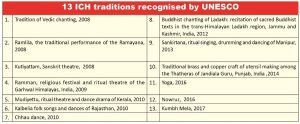
2. DEMAND FOR INCLUSION OF LADAKH IN THE SIXTH SCHEDULE
THE CONTEXT: Recently, a Member of Parliament from Ladakh demanded that the region be included in the Sixth Schedule of the Constitution to safeguard land, employment, and cultural identity of the local population.
THE EXPLANATION:
What is the Sixth Schedule?
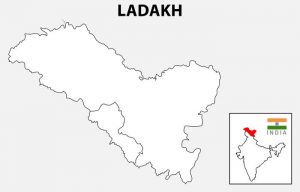 with more than 40 members and the right to make laws on 39 issues.
with more than 40 members and the right to make laws on 39 issues.The Sixth Schedule applies to the Northeastern states of Assam, Meghalaya, Mizoram (three Councils each), and Tripura (one Council).
Why does Ladakh want to be part of the Sixth Schedule?
There was much enthusiasm initially, mostly in Leh, after the August 5, 2019 decisions that created two new Union Territories. Buddhist-dominated Leh district had long demanded UT status because it felt neglected by the erstwhile state government, which was dominated by politicians from Kashmir and Jammu.
The UT has two Hill councils in Leh and Kargil, but neither is under the Sixth Schedule. Their powers are limited to collection of some local taxes such as parking fees and allotment and use of land vested by the Centre.
Voices from the ground:
In Kargil district, which is dominated by Shia Muslims, demands have been raised for the restoration of special status — also for a merger with the UT of J&K which has been provisioned a legislature. Representatives of social, religious, and political groups in Kargil have come together under the banner of the KDA.
Can Ladakh be included in Sixth Schedule?
In September 2019, the National Commission for Scheduled Tribes recommended the inclusion of Ladakh under the Sixth Schedule, noting that the new UT was predominantly tribal (more than 97%), people from other parts of the country had been restricted from purchasing or acquiring land there, and its distinct cultural heritage needed preservation.
Notably, no region outside the Northeast has been included in the Sixth Schedule. In fact, even in Manipur, which has predominantly tribal populations in some places, the autonomous councils are not included in the Sixth Schedule.Nagaland and Arunachal Pradesh, which are totally tribal, are also not in the Sixth Schedule.
According to Home Ministry. “The Ladakh’s inclusion in the Sixth Schedule would be difficult. The Constitution is very clear, Sixth Schedule is for the Northeast. For tribal areas in the rest of the country, there is the Fifth Schedule”.
However, it remains the prerogative of the government — it can, if it so decides, bring a Bill to amend the Constitution for this purpose.
THE CONTEXT: According to a report by the State Centre on Climate Change Shimla and Space Application Centre of the ISRO in Ahmedabad said, that the Himachal Pradesh, a state that has five important perennial rivers fed particularly by glaciers, has witnessed a decline in snowfall over the past year. The area under snow cover in the state has declined by 18.5% between 2019-’20 and 2020-’21.
THE EXPLANATION:
Falling snow cover
The report added that the snow cover in the Chenab basin fell from 7,154 sq km in 2019-’20 to 6,516 sq km in 2020-’21, a reduction of 638 sq km or 8.92%. The Beas basin shows a decrease of about 19% with its average snow cover area having decreased from 2,458 sq km to 2,002 sq km, a loss of 455 sq km. The Ravi basin saw an overall reduction of 23% in the total area under snow cover.
The snow cover in the Sutlej Basin, which covers 45% area of Himachal and is the longest river in the state, shrunk the most by 23.49% or 2,777 sq km. It was 11,823 sq km in 2019-’20 and 9,046 sq km this year.
Another study published in 2019 said that the Sutlej River basin glaciers are melting fast and may shrink significantly by as soon as 2050. The research estimates that the melting would cause 33% of the glaciers to disappear by 2050 and 81% by the end of the century.

Melting glaciers
Not only Himachal, glaciers in Jammu, Kashmir and Ladakh are also melting at a significant rate. According to a 2020 study, over 1,200 glaciers in the region saw an annual reduction in mass of 35 centimetres on average between 2000 and 2012. The study added that the glaciers have reduced from 102 sq km in 1980 to 72 sq km in 2018 showing a recession 28.8% decrease.
The Ganges River system in the Indian Himalayas can be divided into four major river basins i.e the Yamuna, Bhagirathi, Alaknanda and Ghaghara River Basins. The Ganges River system remains the main source of fresh water for half the population of India and Bangladesh and nearly the entire population of Nepal. Reports also mention a decline in snow cover of the Brahmaputra basin.
According to a study Glacio-hydrology of the Himalaya-Karakoram by Ministry of Science and Technology, snow and glaciers are melting rapidly in the Himalayan range due to climate change, altering water supplies in the rivers like Indus, Ganga and Brahmaputra in the Himalaya-Karakoram ranges. Total river runoff, glacier melt and seasonality of flow in these rivers are projected to increase until the 2050s, with some exceptions and large uncertainties.
Panchprayag:
The five holy places of PanchPrayag include:
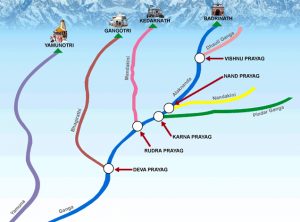
THE CONTEXT:The Prime Minister highlighted the importance of Zero Budget Natural Farming and, he called for the method to become a mass movement.
THE EXPLANATION:
What is Zero Budget Natural Farming?
ZBNF is a method of chemical-free agriculturedrawing from traditional Indian practices. It was originally promoted by agriculturist and Padma Shri recipient Subhash Palekar, who developed it in the mid-1990s as an alternative to the Green Revolution’s methods driven by chemical fertilizers, pesticides and intensive irrigation.
What is it and how did it come about?
According to Subhash Palekar, he argued that the rising cost of these external inputs was a leading cause of indebtedness and suicide among farmers, while the impact of chemicals on the environment and on long-term fertility was devastating. Without the need to spend money on these inputs — or take loans to buy them — the cost of production could be reduced, and farming made into a “zero budget” exercise, breaking the debt cycle for many small farmers.
What is the method?
A similar mixture, called bijamrita, is used to treat seeds, while concoctions using neem leaves and pulp, tobacco and green chillis are prepared for insect and pest management.
The ZBNF method also promotes soil aeration, minimal watering, intercropping, bunds and topsoil mulching and discourages intensive irrigation and deep ploughing. Mr. Palekar is against vermicomposting, which is the mainstay of typical organic farming, as it introduces the most common composting worm, the European red wiggler (Eisenia fetida) to Indian soils. He claims these worms absorb toxic metals and poison groundwater and soil.

Is it effective?
A limited 2017 study in Andhra Pradesh claimed a sharp decline in input costs and improvement in yields. However, reports also suggest that many farmers, including from Mr. Palekar’s native Maharashtra, have reverted to conventional farming after seeing their ZBNF returns drop after a few years, in turn raising doubts about the method’s efficacy in increasing farmers’ incomes.
ZBNF critics, including some experts within the central policy and planning think tank NITI Aayog, note that India needed the Green Revolution in order to become self-sufficient and ensure food security. They warn against a wholesale move away from that model without sufficient proof that yields will not be affected. Sikkim,(First organic state in India) which has seen some decline in yields following a conversion to organic farming, is used as a cautionary tale regarding the pitfalls of abandoning chemical fertilizers.
|
The burden of fertiliser subsidy Fertiliser subsidy in the country amounting to close to INR 79,960 crore in 2019-20 constitutes a sizeable portion of the government’s agricultural subsidies. The urea subsidy alone corners more than 60 percent of the allocation, the rest being nutrient-based subsidies. The total outlay on fertiliser subsidies in 2017–18 in Andhra Pradesh alone is INR 3,485 crore. |
Which are the States with big plans?
The Centre has sanctioned the proposals of eight States for support under the Paramparagat Krishi Vikas Yojana scheme. Andhra Pradesh has the biggest ambition to bring one lakh additional hectares of land under ZBNF under the scheme, followed by Chhattisgarh, with 85,000 additional hectares and Gujarat, with 71,000 additional hectares.
Need of the hour:
While harnessing the advantages of the prescribed natural inputs, it is also important to explore the feasibility of alternatives in case of inaccessibility to critical inputs. Considering the Government’s interest in promoting ZBNF at the national level, the extent of its sustainability needs to be critically monitored in the next few years. An extensive study with a larger sample size and a few demonstration units in small pockets of monitored agricultural land is recommended.
As the prescribed guidelines for ZBNF are similar for all crops and agro-climatic conditions, the single-solution applicability of natural ingredients needs to be tested for all crops and soil types. Close monitoring of the soil health during and after transition would allow us to understand the long-term impact of the practice.
THE INDIAN ECONOMY
THE CONTEXT: The Reserve Bank of India (RBI) introduced a prompt corrective action (PCA) framework for large non-banking financial companies (NBFCs), putting restrictions on para-banks whenever vital financial metrics dip below the prescribed threshold.
THE EXPLANATION:

What is Prompt Corrective Action (PCA)?
THE CONTEXT: A World Trade Organization panel ruled that India violated international trade rules when it offered excessive subsidies for the production and export of sugar and sugarcane.
THE EXPLANATION:
The dispute dates back to 2019 when Brazil, Australia and Guatemala filed parallel WTO complaints that alleged the Indian government massively increased its sugar subsidies and reintroduced a minimum price for sugar, which led to increased production of sugar that outstripped domestic demand.
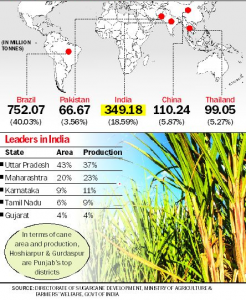
According to Brazil’s complaint, during the 2018-2019 growing season, India approved dozens of federal and state-level assistance programs for the sugar industry that collectively exceeded 55 billion rupees ($730 million).
India’s response:
WTO Agreement on Agriculture:
AoA is aimed to remove trade barriers and to promote transparent market access and integration of global markets. Agreement on agriculture has three components:
Under this provision, the Aggregate Measurement of Support (AMS) is to be reduced by 20% over a period of 6 years by developed countries and 13% over a period of 10 years by developing countries.
Under this, Subsidies are categorized into three parts:
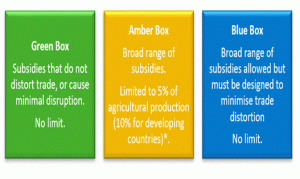
THE CONTEXT: In an attempt to push Semiconductor manufacturing within the country, the Union Cabinet,cleared a Rs 76,000 crore production-linked incentive scheme (PLI) for semiconductor and display manufacturers to make the country an electronic system design and manufacturing global hub.
THE EXPLANATION:

What is the need?
Semiconductors and displays are the foundation of modern electronics driving the next phase of digital transformation under Industry 4.0. Semiconductors and display manufacturing is very complex and technology-intensive sector involving huge capital investments, high risk, long gestation and payback periods, and rapid changes in technology, which require significant and sustained investments.
Following broad incentives have been approved for the development of semiconductors and display manufacturing ecosystem in India:

Semi-conductor Laboratory (SCL): Union Cabinet has also approved that Ministry of Electronics and Information Technology will take requisite steps for modernization and commercialization of Semi-conductor Laboratory (SCL).MeitY will explore the possibility for the Joint Venture of SCL with a commercial fab partner to modernize the brownfield fab facility.
Compound Semiconductors / Silicon Photonics / Sensors (including MEMS) Fabs and Semiconductor ATMP / OSAT Units: The Scheme for Setting up of Compound Semiconductors / Silicon Photonics / Sensors (including MEMS) Fabs and Semiconductor ATMP / OSAT facilities in India shall extend fiscal support of 30% of capital expenditure to approved units. At least 15 such units of Compound Semiconductors and Semiconductor Packaging are expected to be established with Government support under this scheme.
Semiconductor Design Companies: The Design Linked Incentive (DLI) Scheme shall extend product design linked incentive of up to 50% of eligible expenditure and product deployment linked incentive of 6% – 4% on net sales for five years.
India Semiconductor Mission: In order to drive the long-term strategies for developing a sustainable semiconductors and display ecosystem, a specialized and independent “India Semiconductor Mission (ISM)” will be set up. The India Semiconductor Mission will be led by global experts in semiconductor and display industry. It will act as the nodal agency for efficient and smooth implementation of the schemes on Semiconductors and Display ecosystem.
Significance:
BACKGROUND:
What is a Semiconductor?

THE PRELIM PRACTICE QUESTION
1.Consider the following are in the UNESCO intangible heritage sites:
Which of the statements given above are incorrect?
a) 1 and 2 only
b) 2 and 3 only
c) 1 and 3 only
d) None
ANSWER FOR 13TH DECEMBER 2021 PRELIMS PRACTICE QUESTIONS
Answer: c)
Explanation:
THE CONTEXT: The Rajya Sabha passed the Delhi Special Police Establishment (Amendment) Bill, 2021 which seeks to amend the Delhi Special Police Establishment Act, 1946, and the Central Vigilance Commission (Amendment) Bill, 2021. It replaces the Delhi Special Police Establishment (Amendment) Ordinance, 2021.
THE EXPLANATION:
The Central Vigilance Commission (Amendment) Bill, 2021, passed in Lok Sabha in early December 2021. It seeks to extend the tenure of the director of the Enforcement Directorate to a maximum of five years. And also, the bill extends the tenure of the Director of the Central Bureau of Investigation (CBI) to a maximum of five years from the present two years, is a move by the Central Government to check corruption and to ensure and enhance transparency.
According to the Government, the nation is faced with the triple menace of corruption, black money and international crime that is linked to drug trafficking, terrorism and criminal offences and all these are a threat to the security and financial structure of the country.
BACKGROUND:
Delhi Special Police Establishment Act was passed in 1946. CBI derives its powers from the Delhi Special Police Establishment Act, 1946. It was established in 1941 as the Special Police Establishment, entrusted with domestic security. Later, the Santhanam Committee on Prevention of Corruption recommended the establishment of the CBI. It is the main investigating agency of the GOI.
The CBI figures in the Union List of the Seventh Schedule of the constitution of India. Sl. No. 8 of this List reads: “Central Bureau of Intelligence and Investigation.”
About the CBI Director and his appointment:
About Enforcement Directorate:
Composition: Besides directly recruiting personnel, the Directorate also draws officers from different Investigating Agencies, viz., Customs & Central Excise, Income Tax, Police, etc. on deputation. Now the tenure of the director of the Enforcement Directorate is up to a maximum of 5 years.
THE CONTEXT: India voted against a draft resolution at the United Nations Security Council (UNSC) linking climate to security, saying it was an attempt to shift climate talks from the United Nations Framework Convention on Climate Change (UNFCCC) to the Security Council and a “step backward” for collective action on the issue.
THE EXPLANATION:
India was the only other country in the 15-member group to vote against the move. One of the objectives of the debate was to examine how terrorism and security risks could be linked to climate change, as per a concept note circulated by Niger.
What was the proposal?
Undermining progress
About UNSC:

THE CONTEXT: The Centre used a competitive process to select 100 cities for upgradation with significant investments through the Smart Cities Mission (SCM) launched on June 25, 2015.
THE EXPLANATION:
THE STATUS OF THE SMART CITIES MISSION:
|
Smart City Mission
|
How far have smart cities progressed?
The Urban Affairs Ministry says that as of November 12, 2021, a total of 6,452 projects at a cost of ₹1,84,998 crore had been tendered. In terms of work progress, 5,809 projects worth ₹1,56,571 crore were under implementation or had been completed, it says, although it is not clear how many were completed.
Image Courtesy: Smart city mission, GOI
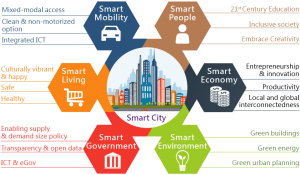
What challenges are faced by smart city plans?
THE CONTEXT: Wholesale inflation, based on the Wholesale Price Index, jumped to 14.23 per cent in November from 12.54 per cent in October 2021 (on a year-on-year basis), primarily due to a rise in food prices especially of vegetables, and minerals and petroleum products, data released by the Ministry of Commerce & Industry.
THE EXPLANATION:

Factors behind the uptick
Value Addition:

THE CONTEXT: The Manila-based lender now sees 2021 gross domestic product (GDP) growth of 7.0% for developing Asia, down from 7.1%, and 2022 growth of 5.3%, down from 5.4% in September 2021.
THE EXPLANATION:
For India:
About ADB:
Who can be its members?
Voting rights:
Roles and functions:
THE CONTEXT: According to the Ministry of Home Affairs, 11 States and one Union Territory have boundary disputes between them. It added that “occasional protests and incidents of violence are reported from some of the disputed border areas”.
THE EXPLANATION:
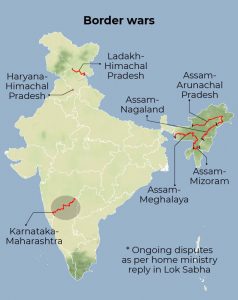
“There are boundary disputes arising out of demarcation of boundaries and claims and counter-claims over territories between Andhra Pradesh-Odisha, Haryana-Himachal Pradesh, Union Territories of Ladakh-Himachal Pradesh, Maharashtra-Karnataka, Assam-Arunachal Pradesh, Assam-Nagaland, Assam-Meghalaya, Assam-Mizoram”.
Assam-Mizoram:
Mizoram borders Assam’s Barak Valley, and both border Bangladesh. The boundary between the two states, which runs 165 km today, has a history dating back to the time when Mizoram was a district of Assam and known as Lushai Hills. Boundary demarcations in 1875 and 1933, particularly the second one, are at the heart of the dispute.
The 1875 demarcation, notified on August 20 that year, derived from the Bengal Eastern Frontier Regulation (BEFR) Act, 1873. It differentiated Lushai Hills from the plains of Cachar in Assam’s Barak Valley. This was done in consultation with Mizo chiefs, and it became the basis for the Inner Line Reserve Forest demarcation in the Gazette.
Assam-Arunachal Pradesh
The boundary issue between Assam and Arunachal is as ancient as the reign of the Ahom Kings who ruled Assam till the British annexed Assam in 1826. Encroachments by residents across the 804-km border that Assam shares with Arunachal Pradesh have led to rising tensions occasionally. A suit has been pending in Supreme Court since 1989 on the issue. Border Roads Organisation has marked Kim in Arunachal Pradesh as part of Assam by mistake.
Assam-Nagaland
Assam and Nagaland share a 434-km border and the disputes relate to 66000 Sq Km of land mostly along the Sivasagar district of Assam. The two states have been disputing their shared border ever since Nagaland was carved out of Assam’s Naga Hills district. While Assam wants the status quo and sticks to the border decision taken on December 1, 1963, Nagaland demands all Naga territories be transferred to the state. Claiming that all Naga territories belong to them, Nagaland wants restoration of land-based on a 16-point agreement of 1960, which led to the creation of the state.
Assam-Meghalaya
Meghalaya shares its internal border only with Assam and there are disputes along the 733 km border at 12 places. The border row between both States started with the formation of states under the North-Eastern Areas (Reorganisation) Act, 1971. As per the Act, Blocks I and II of the Mikir Hills—presently, the Karbi Anglong district—were granted to Assam. Meghalaya claims that both these blocks were part of the erstwhile United Khasi and Jaintia Hills when it was created in 1835.
Himachal Pradesh-Haryana
Himachal Pradesh has an inter-state boundary dispute at Parwanoo with Haryana. Haryana also claims that a large area of the land bordering Himachal in Parwanoo belongs to them and has asked the Survey of India to demarcate the land. Haryana blames that Himachal does not accept joint forest demarcations. A Survey of India had recently reported that Himachal Pradesh encroached upon some land at Parwanoo that belongs to Haryana.
Ladakh-Himachal Pradesh
Sarchu, situated at an elevation of 4,290 metres on the Leh-Manali highway, is a disputed territory between Ladakh and Himachal Pradesh.
Maharashtra-Karnataka
Maharashtra is claiming Marathi-speaking regions consisting of more than 800 villages of Belgaum, Karwar and Nippani that were included in Karnataka. Belgaum district in Karnataka, which has both Kannada and Marathi speakers, was added to Karnataka in 1956 when states were reorganised on a linguistic basis. As part of the Bombay Presidency in British India, Belgaum was under Bombay state. Karnataka says that some of its Kannada-majority villages had been included in Maharashtra.
Andhra Pradesh and Odisha
The border dispute between Andhra Pradesh and Odisha over the contentious Kotia Gram Panchayat in the Koraput district. The Kotia Gram Panchayat has 28 revenue villages; Odisha mistakenly did not survey 21 villages during its formation in 1936. At the time of the creation of Andhra Pradesh in the year 1955, those 21 villages were also not surveyed by Andhra resulting in a perpetual dispute over these bordering villages.
Q1. Consider the following statements about the Wholesale Price Index (WPI):
Which of the statements given above is/are incorrect?
a) 1 and 2 only b) 2 and 3 only
c) 3 only d) 1 and 3 only
Answer: D
Explanation:
THE CONTEXT: The Indian government has finalized an air bubble agreement with Australia, which will allow all eligible passengers to travel between the two countries.
THE EXPLANATION:
What is Air Bubble Agreement?
With other countries:
India currently has bilateral air bubble agreements with 33 countries, which include Afghanistan, Australia, Bahrain, Bangladesh, Bhutan, Canada, Ethiopia, Finland, France, Germany, Iraq, Japan, Kenya, Kuwait, Maldives, Mauritius, Nepal, Netherlands, Nigeria, Oman, Qatar, Russia, Rwanda, Singapore, Seychelles, Switzerland, Sri Lanka, Tanzania, the UAE, the UK, and the USA, Ukraine and Uzbekistan.
THE CONTEXT: India is awaiting responses from leaders of five Central Asian nations to an invitation to attend as chief guests of Republic Day, with the details expected to be finalised during a ministerial-level meeting of the India-Central Asia Foreign Ministers’ dialogue (third India-Central Asia Dialogue).
THE EXPLANATION:
India- Central Asia relations:
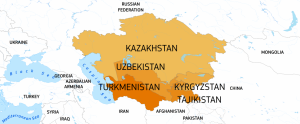
THE CONTEXT: According National Academies of Sciences, Engineering and Medicine report, the US produces a large share of the global supply of plastic resin – the precursor material to all plastic industrial and consumer products. It also imports and exports billions of dollars’ worth of plastic products every year.
THE EXPLANATION:
Impacts on marine ecosystems
According to IUCN, the most visible impacts of plastic debris are the ingestion, suffocation and entanglement of hundreds of marine species. Marine wildlife such as seabirds, whales, fish and turtles mistake plastic waste for prey; most then die of starvation as their stomachs become filled with plastic.
How India can face the tidal wave of marine plastic
The Way forward:
Initiatives to Curb Plastic Waste
THE CONTEXT: The Centre has approached the Supreme Court seeking modification of its order directing that all transmission cables in the habitat of the Great Indian Bustard (GIB) be laid underground, saying that the area falling in Rajasthan and Gujarat contains a large proportion of the country’s total solar and wind energy potential and the process will escalate the cost of renewable energy production and hurt India’s renewable energy cause.
THE EXPLANATION:
ABOUT GREAT INDIAN BUSTARD:
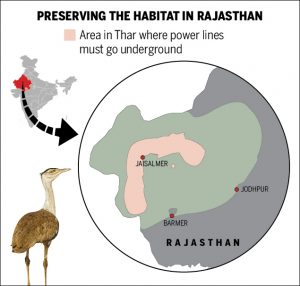
Protected areas:
Recent Development:
India’s proposal to include Great Indian Bustard, Asian Elephant and Bengal Florican in Appendix I of UN Convention on migratory species was unanimously accepted during the 13th Conference of the Parties to the Convention on Migratory Species (CMS). This conference was held at Gandhinagar in Feb 2020. The mascot for CMS COP13 was “Gibi – The Great Indian Bustard”.
THE CONTEXT: Recently, several banks have entered into co-lending ‘master agreements’ with NBFCs, and more are in the pipeline. This, however, has come in for criticism from several quarters.
THE EXPLANATION:
What is Co-Lending Model?
How does a co-lending model work?
SBI AND ADANI TIE-UP:
Risk in co-lending
Corporates in banking
Value Addition:
Non-Banking Financial Corporation (NBFC)
NBFC business:
Difference between Banks and NBFCs:
THE CONTEXT: A supersonic missile-assisted torpedo system (SMART) developed by the Defence Research and Development Organisation (DRDO) was successfully launched from Wheeler Island in Odisha.
THE EXPLANATION:
What is SMART?
What is Supersonic Missile?

THE CONTEXT: According to WHO, the novel coronavirus disease (COVID-19) pandemic disrupted global health services and dealt a debilitating blow to people’s “ability to obtain healthcare and pay for it”.
THE EXPLANATION:
Around half a billion people were pushed into extreme poverty because they had to pay healthcare costs. A wide gap in affordable healthcare access, combined with reduced income can exacerbate crisis.
Q1. Which of the following index is not compiled by Labour Bureau in the Ministry of Labour and Employment?
a) CPI for Industrial Workers (IW)
b) CPI for Agricultural Labourer (AL)
c) CPI for Rural Labourer (RL)
d) CPI (Rural/Urban/Combined)
Answer: a)
Explanation:
French territories:
THE CONTEXT: According to the Ministry of Home Affairs, that there is no proposal under consideration to scrap Section 124A of the Indian Penal Code, 1860. Further, the question of law regarding Section 124A is pending for adjudication before the Supreme Court of India.
THE EXPLANATION:
What is the controversy?
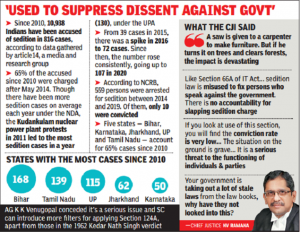
About Sedition Law
Section 124A states:
Trials of Tilak and Gandhi
Arguments For Section 124A
Arguments Against Section 124A
Supreme Court’s Earlier Stand
THE CONTEXT: A controversy has erupted in Kerala over the reappointment of Vice Chancellor of Kannur University, with Kerala Governor saying he approved the decision against his “better judgement” as Chancellor. In a letter to Chief Minister, Governor expressed his desire to step down as Chancellor, alleging political interference in the universities.
What is the role of Governors in state universities?
What about central universities?
THE CONTEXT: A group of Opposition MPs in Sri Lanka, representing Tamils from the north and east, hill country (Malaiyaha Tamils), and Tamil-speaking Muslims sought the full implementation of the 13th Amendment to ensure “existing rights are not snatched away”.
THE EXPLANATION:
What is the Accord?

Why the 13th Amendment contentious?
Stance of India
India has always emphasised on a meaningful devolution package, based on the 13th Amendment. India’s interest is not only cultural but also demographic as around 1 lakh Tamil refugees are living in India. Until a political reconciliation is achieved in Sri Lanka, return of these refugees will not be possible.
THE CONTEXT: Voters in the French island territory of New Caledonia chose overwhelmingly to stay part of France, in a referendum boycotted by pro-independence forces.
THE EXPLANATION:

BACKGROUND:
New Caledonia
French Overseas Territories:
The French Overseas Territories cover almost 120 000 km² and are home to more than 2.6 million people.
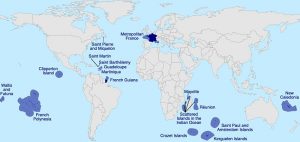
THE CONTEXT: A camera trap set up at Buxa Tiger Reserve (BTR) in Alipurduar district of West Bengal have captured a sight of Royal Bengal Tiger, that the region has not witnessed in more than two decades.
THE EXPLANATION:
About Buxa Tiger Reserve:
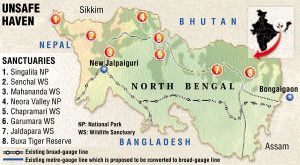
The Royal Bengal Tiger:
The Royal Bengal Tiger belongs to specific population of the Panthera tigris tigris subspecies, which is native to the Indian subcontinent. The tiger is threatened by poaching and fragmentation of habitat. India’s tiger population was 2,967 in 2019. 300–500 tigers are found in Bangladesh, 220–274 in Nepal while 103 tigers in Bhutan. In the red list of IUCN, it has been list into Endangered category.
THE CONTEXT: Recently, Sakkarbaug zoo of Junagadh in Gujarat as three of its Asiatic lionesses have given birth to 13 cubs.
THE EXPLANATION:
The Sakkarbaug Zoological Garden is a 210-acre facility that provides pure-bred Asiatic lions for the Indian and international endangered species captive-breeding programme. Wild, free-ranging Asiatic lions have become extinct in most parts of Asia and are now found only in and around the Gir Forest.
However, it is important to note that, Sakkarbaug Zoo of Junagadh is the only breeding centre in the world for Asiatic lions, and the Gir Forest, the Asiatic lion population went to 674 in 2020.”
ABOUT ASIATIC LION:
Conservation Status:
Factors responsible for steady rise in population:
Over the last several years, the lion population in Gujarat has been steadily rising.
This is powered by:
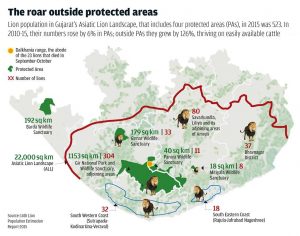
THE CONTEXT: According to the Ministry of Environment, forest, and climate change, between 2018 and 2020, about 2,054 cases were registered for killing or illegal trafficking of wild animals in India.
THE EXPLANATION:
About Wildlife Crime Control Bureau:
Under the Wildlife (Protection) Act, 1972, WCCB is mandated to
THE CONTEXT: “The DRDO, along with the Army, conducted a series of performance evaluation trials. In these trials, enhanced range Pinaka rockets were test-fired at different ranges with various warhead capabilities. All the trial objectives were met satisfactorily. 24 rockets were fired for different ranges and warhead capabilities to meet the objectives of accuracy and consistency.”
THE EXPLANATION:
Also stated with this, the initial phase of technology absorption of the Pinaka-ER (Enhanced Range) by the industry partner has successfully been completed, making the upgraded rocket system ready for production.
What is Pinaka-ER?
The Pinaka-ER is the upgraded version of the earlier Pinaka, which has been in service with the Indian Army for the last decade. The system has been designed in light of emerging requirements with advanced technologies. The extended range of the new Pinaka is over 70 km, as opposed to the 45 km the system currently has.
About Pinaka Rocket System:
THE CONTEXT: IIT Madras researchers developed this tool using deep learning and traditional machine learning to develop a tool that can diagnose cancer by looking at whole slide images of the tumour. The tool has been tested on datasets of breast, liver and colon cancer tissue images.
THE EXPLANATION:
Digital histopathology
Algorithms:
To test the algorithms, the researchers enrolled in three open challenges – the CAMELYON17 challenge, the DIGESTPATH 2019 challenge and the PAIP 2019 challenge. “This paper takes data from three different challenges. In two of these, we were placed in the top 3 performing methods and in one challenge (CAMELYON) we were placed in the top 10 out of several hundred entries.
Q1. Which of the following pairs of French overseas territory is incorrectly matched?
Select the correct answer using codes given below?
a) 1 only b) 1 and 2
c) 2 and 3 d) 1, 2 and 3
Answer: a)
Explanation:
THE CONTEXT: Amid continuous protests in Gwadar, Balochistan against mega development plans of the port city as part of the China-Pakistan Economic Corridor. Despite the severe conservatism of Balochistan, women protesters have come out in large numbers.
THE EXPLANATION:

Concerns of India, West
India has been concerned that Gwadar, which gives China strategic access to the Arabian Sea and the Indian Ocean, is not just being developed as a trade entrepot but as a dual-purpose port for use by PLAN (the Chinese Navy) and is intended to expand Chinese presence in the Indian Ocean Region alongside Kyaukpyu in Myanmar and Hambantota in Sri Lanka. With vital military interests in West Asia, the US too is concerned about the Chinese presence in Gwadar.
About CPEC:
THE CONTEXT: According to the update of the IUCN Red List of Threatened Species, the number of species is at risk of extinction on the Red List has exceeded 40,000 for the first time. The destruction of wetlands is leading to the decline of dragonflies worldwide.
THE EXPLANATION:
 f unsustainable agriculture and urbanization around the world. The IUCN Red List now includes 142,577 species of which 40,084 are threatened with extinction.
f unsustainable agriculture and urbanization around the world. The IUCN Red List now includes 142,577 species of which 40,084 are threatened with extinction.PYRENEAN DESMAN

Threats:
THE CONTEXT: Radioactive pollution of water is newly emerging but is of grave concern for water pollution and human health. Recently, radioactive contamination and associated health impacts have been reported in many parts of the globe.
What is Radioactive Pollution?
Radioactive pollution in water:
Percolation of naturally occurring radioactive materials (NORM) from the soil sediments to the aquifer causes groundwater contamination. In anthropogenic sources of radioactive pollution, nuclear weapon investigation, nuclear calamities, nuclear power houses and dumping of radioactive waste are major sources of contamination, while application of radioisotopes in industries and scientific laboratories are the minor sources.
Example:
Radioactivity is measured in Becquerel (SI unit) or in Curie. Energy absorbed per unit mass is measured by Gray, while the unit Sievert measures the quantity of radiation absorbed by human tissues.
A small amount of radiation is found in all types of water but the extended amount of radiation is harmful to human health. Radioactivity in drinking water can be determined by a gross alpha test.
The World Health Organization set guidelines for drinking water quality and a permissible limit of reference dose level of 0.1 micro-sieverts per year. The United States Environmental Protection Agency released guidelines known as ‘radionuclides rule’. This rule recognised standards of:
|
The harmful impacts of nuclear radiation are:
Nowadays, proper analysis and monitoring of radioactive pollutants are also required for a safe water supply. Prevention and precaution measures can check the anthropogenic sources of radioactive contamination in water resources.
Various treatment methods like aeration, reverse osmosis, ion exchange and granule carbon adsorption are effective remedial measures for treating the radioactive contaminated water.
THE CONTEXT: According to the European Union’s Copernicus Atmosphere Monitoring Service, some of the coldest regions of the world have been on fire in 2021, some even through the winter months, indicating an influence of a changing climate. Wildfires around the world emitted 1.76 billion tonnes of carbon in 2021 (till November 30, 2021 ).
THE EXPLANATION:
Impacts on India
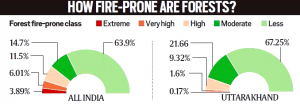
Significance of Forests:
Efforts to Mitigate Forest Fires:
THE CONTEXT: NASA launched a new mission named Imaging X-ray Polarimetry Explorer or IXPE. Onboard SpaceX’s Falcon 9 rocket, it was sent to its orbit from NASA’s Kennedy Space Center in Florida.
THE EXPLANATION:
What are the instruments onboard?
Why is it important?
According to NASA, IXPE’s polarization measurements will help scientists answer questions such as:
THE CONTEXT: India Skills Report 2022 was released by Wheebox, a talent assessment platform, with AICTE, Association of Indian Universities, Confederation of Indian Industries, and other agencies.
THE EXPLANATION:

Analysis of the report:
Q1. Consider the following statements about International Solar Alliance (ISA):
Which of the statements are correct?
a) 1 and 2 only b) 2 and 3 only
c) 1 and 3 only d) All of them
Answer: a)
Explanation:
THE CONTEXT New Zealand has announced it will outlaw smoking for the next generation so that those who are aged 14 and under will never be legally able to buy tobacco.
THE EXPLANATION:
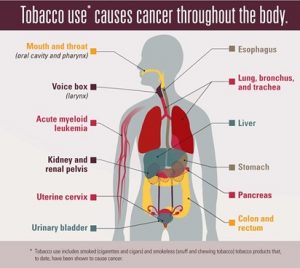 de earlier.
de earlier.INDIA’S MEASURES:
Objectives
THE CONTEXT: According to the Ministry of Earth Sciences, the number of Cyclones and the Number of stations reported very heavy and extremely heavy rainfall events have increased in recent years.
THE EXPLANATION:
Oxygen makes up one-fifth of the air we breathe, and few recent studies reported declining oxygen content in the atmosphere due to the burning of fossil fuels, population growth and deforestation. However, the loss of oxygen is negligible when compared to its abundance in the atmosphere and it is also found that the ecosystem is compensating for some of the loss.
Ministry of Earth Sciences has the mandate only to provide forecasts and early warnings. However, as an adaptive measure to minimize the effects of increasing temperatures, IMD in collaboration with local health departments have started a heat action plan in many parts of the country to forewarn about the heat waves and also advise action to be taken during such occasions. The heat action plan became operational in 2013.
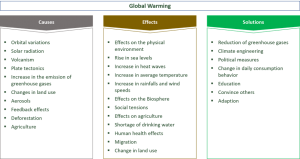
Heat Action Plan
The Heat Action Plan is a comprehensive early warning system and preparedness plan for extreme heat events. The Plan presents immediate as well as longer-term actions to increase preparedness, information-sharing, and response coordination to reduce the health impacts of extreme heat on vulnerable populations. NDMA and IMD are working with 23 states prone to high temperatures at present with respect to the heat action plans.
| Intergovernmental Panel on Climate Change (IPCC)’s Sixth Assessment Report
· The current global warming trends overall are likely to lead to an increase in annual mean precipitation over India, with more severe rains expected over southern India in the coming decades. · In the most ambitious emissions pathway, the projection is that globe would reach the 1.5°C in the 2030s, overshoot to 1.6°C, with temperatures dropping back down to 1.4°C at the end of the century. · India is currently the world’s third-largest greenhouse gas emitter, but per capita emissions are much lower. The U.S. emitted nearly 9 times more greenhouse gases per capita than India in 2018. Based on existing commitments by countries to curb their emission, the world is on track for global temperature warming by at least 2.7°C by 2100, predicts the report, calling it ‘Code red for humanity’. Impact on India The report, warns that with a 7,517 km coastline, India will face significant threats from rising seas. Across six Indian port cities — Chennai, Kochi, Kolkata, Mumbai, Surat and Visakhapatnam — 28.6 million people will be exposed to coastal flooding if sea levels rise 50cm. |
THE CONTEXT: The United Nations Convention on Biological Diversity’s Aichi targets to set goals for each country to create protected areas in 2010, and roughly 15 per cent of the world’s land surface is under official state protection. Protected areas have largely been able to reduce deforestation.
THE EXPLANATION:
Indigenous lands and deforestation:
Forest degradation
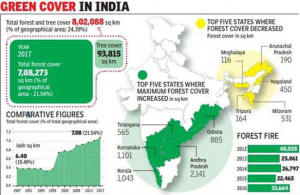
Remedial Measures
Value Addition:
About CBD:
What are Aichi Targets?
The ‘Aichi Targets’ were adopted by the Convention on Biological Diversity (CBD) at its Nagoya conference. It is a short term plan provides a set of 20ambitious yet achievable targets, collectively known as the Aichi Targets. They can be divided into:
THE CONTEXT: Recent trends suggest that smugglers of exotic wildlife species might be trying to take advantage of the advisory brought out by the Ministry of Environment, Forest & Climate Change (MoEF&CC) to regulate the growing market of exotic animals in the country.
THE EXPLANATION:
What is the government’s voluntary disclosure scheme?
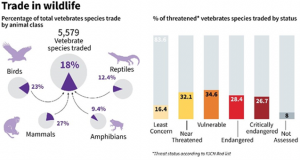
How big a problem is the illegal trade of exotic animals in India?
The Directorate of Revenue Intelligence (DRI), which enforces anti-smuggling laws, stated India has emerged as a big demand centre for exotic birds and animals with an increase in the smuggling of endangered species from different parts of the world. Most of this exotic wildlife is imported through Illegal channels and then sold in the domestic market as pets.
What kind of exotic wildlife are covered?
The advisory has defined exotic live species as animals named under Appendices I, II and III of the CITES. It does not include species from the Schedules of the Wild Life (Protection) Act 1972. The advisory excludes exotic birds from the amnesty scheme.
CITES (Convention on International Trade in Endangered Species of Wild Fauna and Flora):
Identification of beneficiaries eligible for assistance and their prioritisation to be done using information from Socio Economic and Caste Census (SECC) ensuring total transparency and objectivity. The list will be presented to Gram Sabha to identify beneficiaries who have been assisted before or who have become ineligible due to other reasons.
Q1. Which of the following is incorrectly matched?
Select the correct answer using the code given below:
a) 1 only b) 1 and 2 only
c) 2 and 3 only d) 3 only
Answer: C
Explanation: Ken river-